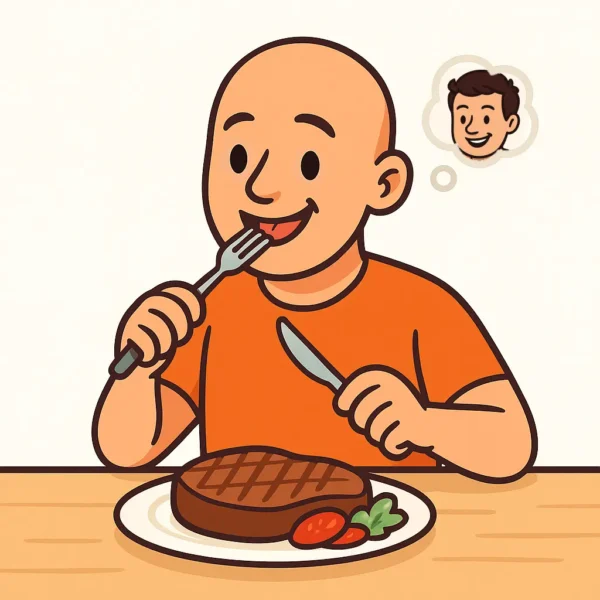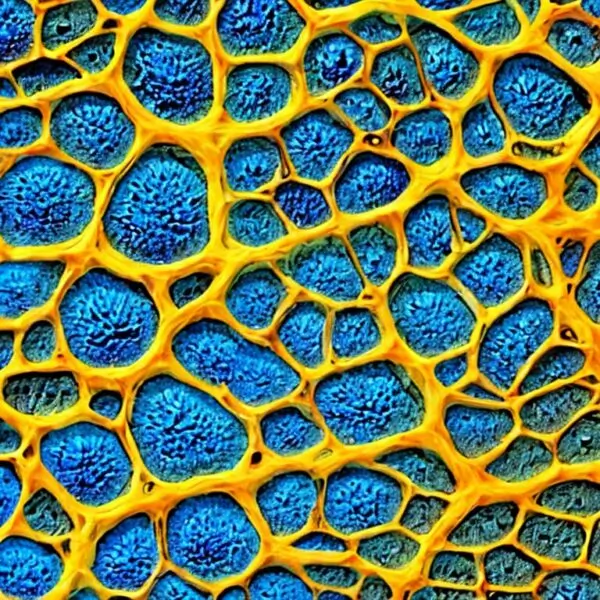The short answer is – possibly – but a causal effect has not been conclusively proven. Diet can influence hormonal and metabolic pathways that are central to androgenetic alopecia (AGA), and several ecological and observational studies suggest links between “Westernized” eating patterns and pattern hair loss. However, interventional trials showing that changing diet alone prevents or slows AGA are lacking.
What AGA is and why diet entered the debate: AGA reflects progressive miniaturization of scalp hair follicles in genetically susceptible individuals under the influence of androgens, particularly dihydrotestosterone (DHT). The condition is highly heritable, yet its expression varies across populations and time, which keeps environmental factors, including diet, on the table as potential modifiers rather than prime movers. Current summaries of AGA pathobiology emphasize androgen signaling and follicular susceptibility, with increasing recognition of metabolic comorbidities.
The “Westernization” hypothesis (Japan and China): Mid-20th-century reports described a lower prevalence and later onset of AGA in Japanese and Chinese men than in Caucasian men; later clinical reviews in Asian cohorts still show a generally lower prevalence and milder patterns, though with variation by country and age. Over the same decades, national nutrition surveys document that Japanese diets have steadily Westernized – more animal fat, red meat, and dairy; less traditional seafood- and plant-forward fare. These parallel trends have led some dermatologists to hypothesize that dietary change could narrow historical prevalence gaps. That ecological reasoning is plausible but remains circumstantial: prevalence data and diet trends correlate at population level, not individual level, and many social and health transitions co-occurred post-war.
What controlled human studies say about diet and the androgen milieu: Two classic studies often cited in this discussion compared men following vegetarian/vegan versus omnivorous diets. Bélanger et al. (1989) found that vegetarians had higher sex hormone-binding globulin (SHBG) and a lower free androgen index, with differences in androgen glucuronide metabolites; Key et al. (1990) similarly reported 23% higher SHBG in vegans, with little change in calculated free testosterone. The implication is that higher-fat, meat-rich diets may lower SHBG and nudge bioavailable androgens upward, whereas plant-forward diets may do the reverse – subtly shifting the hormonal context in which AGA unfolds. These studies did not measure hair outcomes, but they show a diet-hormone link relevant to AGA biology.
A related thread concerns insulin and IGF-1 signaling. Vegan and vegetarian cohorts often show lower IGF-1 or higher SHBG than meat-eaters, again suggesting diet can modulate endocrine tone. Dairy intake, in particular, is repeatedly associated with modest increases in circulating IGF-1 in adults. While this is mechanistically interesting – IGF-1 influences follicular cycling – these findings still stop short of demonstrating diet-driven changes in AGA incidence or progression.
Cross-cultural endocrine comparisons support environmental effects: In a careful study designed to probe mechanisms behind ethnic differences in androgen biology, Santner et al. (1998) found similar 5α-reductase activity in Chinese and Caucasian men but higher excretion of androgenic ketosteroids in Caucasians. Importantly, Chinese men living in Beijing had lower testosterone production and SHBG than Chinese men living in Pennsylvania, pointing to environmental – very likely dietary – drivers rather than fixed genetic differences. This supports the idea that diet can set the hormonal “background” against which AGA risk is expressed, even if it does not prove dietary causation for baldness.
Metabolic health as a mediator: Multiple lines of evidence tie AGA – especially early-onset disease – to insulin resistance and features of the metabolic syndrome. A 2022 systematic review and meta-analysis found that individuals with AGA had a worse metabolic profile and higher odds of metabolic syndrome than controls. Earlier clinical observations linked early AGA with hyperinsulinaemia independent of overt diabetes. Mechanistically, hyperinsulinaemia can suppress SHBG and may enhance intrafollicular androgen signaling, plausibly accelerating miniaturization in predisposed scalp regions. Diets high in refined carbohydrates and simple sugars promote insulin resistance over time; if metabolic dysfunction is part of the AGA milieu, dietary patterns that worsen or improve insulin sensitivity could secondarily modulate AGA risk or tempo.
What newer observational studies say about specific foods and drinks: Recent work in young Chinese men reported an association between higher consumption of sugar-sweetened beverages (SSBs) and male pattern hair loss. As with most nutrition-hair studies, this was cross-sectional: it cannot prove that SSBs cause AGA, but it aligns with the insulin/IGF-1 narrative and raises a concrete, modifiable exposure for future trials. A broader 2025 review likewise concluded that alcoholic and sugary beverages correlate with greater hair loss across studies, while emphasizing the limitations of cross-sectional data.
Soy, isoflavones, and equol – the counterpoint: At the other end of the spectrum, soy isoflavones and the microbiome-derived metabolite equol (which binds DHT) have been explored as potentially protective. In healthy Japanese men, short-term isoflavone supplementation increased SHBG and lowered serum DHT; equol itself has anti-androgenic properties in experimental systems. Yet robust randomized trials demonstrating clinically meaningful effects on AGA are not available, and “equol-producer” status varies between individuals and populations. These compounds illustrate how dietary constituents might modulate androgen pathways, but their relevance to real-world AGA outcomes remains to be proven.
So does diet promote AGA – what would count as proof: To move from “possible” to “probable,” we would need prospective longitudinal cohorts showing that specific dietary patterns precede (and predict) incident or faster-progressing AGA after adjustment for confounders, and/or randomized dietary interventions demonstrating slower miniaturization or reduced progression on objective endpoints (e.g., phototrichogram, hair counts) in genetically susceptible men. At present, we have (i) ecological signals from Westernization, (ii) human studies showing diet-dependent shifts in SHBG, testosterone metabolites, and IGF-1, (iii) metabolic-syndrome links consistent with macronutrient quality effects, and (iv) cross-sectional associations with SSBs and alcohol. That constellation supports biological plausibility and modifiable risk but not causality.
Bottom line: Diet likely does modify the hormonal and metabolic context in which genetically programmed balding plays out. Westernized patterns – particularly high intake of sugary drinks and alcohol and overall dietary patterns that degrade insulin sensitivity – may tilt that context toward greater androgen bioactivity and faster miniaturization. Conversely, plant-forward diets and certain components such as soy might attenuate androgenic tone. But definitive clinical proof that diet alone promotes or prevents AGA remains to be generated.
Bibliography
11711645 {11711645:HJKKTH67},{11711645:AW79C5ZR},{11711645:58ZZ6W4G},{11711645:NVK28WM2},{11711645:GNSUSWJ3},{11711645:5JYCB2EE},{11711645:JQKFTV2P},{11711645:W95Q6QRC},{11711645:6RYWE22B},{11711645:RNILWGD2},{11711645:PUPNIE5B},{11711645:ZLQDT2VF},{11711645:CCWJFLUI},{11711645:YFLCQHMH},{11711645:9W69NUXY},{11711645:T843RTX3} 1 vancouver 50 date asc 1943 https://www.keratin.com/wp-content/plugins/zotpress/ %7B%22status%22%3A%22success%22%2C%22updateneeded%22%3Afalse%2C%22instance%22%3Afalse%2C%22meta%22%3A%7B%22request_last%22%3A0%2C%22request_next%22%3A0%2C%22used_cache%22%3Atrue%7D%2C%22data%22%3A%5B%7B%22key%22%3A%226RYWE22B%22%2C%22library%22%3A%7B%22id%22%3A11711645%7D%2C%22meta%22%3A%7B%22creatorSummary%22%3A%22B%5Cu00e9langer%20et%20al.%22%2C%22parsedDate%22%3A%221989-06%22%2C%22numChildren%22%3A0%7D%2C%22bib%22%3A%22%26lt%3Bdiv%20class%3D%26quot%3Bcsl-bib-body%26quot%3B%20style%3D%26quot%3Bline-height%3A%201.35%3B%20%26quot%3B%26gt%3B%5Cn%20%20%26lt%3Bdiv%20class%3D%26quot%3Bcsl-entry%26quot%3B%20style%3D%26quot%3Bclear%3A%20left%3B%20%26quot%3B%26gt%3B%5Cn%20%20%20%20%26lt%3Bdiv%20class%3D%26quot%3Bcsl-left-margin%26quot%3B%20style%3D%26quot%3Bfloat%3A%20left%3B%20padding-right%3A%200.5em%3B%20text-align%3A%20right%3B%20width%3A%201em%3B%26quot%3B%26gt%3B1.%26lt%3B%5C%2Fdiv%26gt%3B%26lt%3Bdiv%20class%3D%26quot%3Bcsl-right-inline%26quot%3B%20style%3D%26quot%3Bmargin%3A%200%20.4em%200%201.5em%3B%26quot%3B%26gt%3BB%26%23xE9%3Blanger%20A%2C%20Locong%20A%2C%20Noel%20C%2C%20Cusan%20L%2C%20Dupont%20A%2C%20Pr%26%23xE9%3Bvost%20J%2C%20et%20al.%20Influence%20of%20diet%20on%20plasma%20steroids%20and%20sex%20hormone-binding%20globulin%20levels%20in%20adult%20men.%20J%20Steroid%20Biochem.%201989%20June%3B32%286%29%3A829%26%23x2013%3B33.%26lt%3B%5C%2Fdiv%26gt%3B%5Cn%20%20%20%26lt%3B%5C%2Fdiv%26gt%3B%5Cn%26lt%3B%5C%2Fdiv%26gt%3B%22%2C%22data%22%3A%7B%22itemType%22%3A%22journalArticle%22%2C%22title%22%3A%22Influence%20of%20diet%20on%20plasma%20steroids%20and%20sex%20hormone-binding%20globulin%20levels%20in%20adult%20men%22%2C%22creators%22%3A%5B%7B%22creatorType%22%3A%22author%22%2C%22firstName%22%3A%22A.%22%2C%22lastName%22%3A%22B%5Cu00e9langer%22%7D%2C%7B%22creatorType%22%3A%22author%22%2C%22firstName%22%3A%22A.%22%2C%22lastName%22%3A%22Locong%22%7D%2C%7B%22creatorType%22%3A%22author%22%2C%22firstName%22%3A%22C.%22%2C%22lastName%22%3A%22Noel%22%7D%2C%7B%22creatorType%22%3A%22author%22%2C%22firstName%22%3A%22L.%22%2C%22lastName%22%3A%22Cusan%22%7D%2C%7B%22creatorType%22%3A%22author%22%2C%22firstName%22%3A%22A.%22%2C%22lastName%22%3A%22Dupont%22%7D%2C%7B%22creatorType%22%3A%22author%22%2C%22firstName%22%3A%22J.%22%2C%22lastName%22%3A%22Pr%5Cu00e9vost%22%7D%2C%7B%22creatorType%22%3A%22author%22%2C%22firstName%22%3A%22S.%22%2C%22lastName%22%3A%22Caron%22%7D%2C%7B%22creatorType%22%3A%22author%22%2C%22firstName%22%3A%22J.%22%2C%22lastName%22%3A%22S%5Cu00e9vigny%22%7D%5D%2C%22abstractNote%22%3A%22Several%20experimental%20studies%20have%20suggested%20that%20diet%20can%20alter%20the%20production%20and%20metabolism%20of%20steroids%20in%20men.%20The%20purpose%20of%20this%20study%20was%20to%20determine%20the%20levels%20of%20unconjugated%20steroids%20and%20steroid%20glucuronides%20as%20well%20as%20sex%20hormone-binding%20globulin%20%28SHBG%29%20among%20normal%20adult%20men%20who%20were%20either%20omnivorous%20or%20vegetarians.%20The%20participants%20were%20white%20volunteers%20ranging%20from%2025-35%20years%20of%20age%20and%20the%20blood%20samples%20were%20taken%20between%200900%20h%20and%201000%20h%20and%20between%201600%20h%20and%201700%20h%20for%20two%20consecutive%20days.%20No%20significant%20statistical%20change%20was%20found%20in%20plasma%20dehydroepiandrosterone%2C%20dehydroepiandrosterone%20sulfate%2C%20testosterone%2C%20dihydrotestosterone%20and%20estradiol%20levels.%20Vegetarian%20group%20showed%20a%20higher%20levels%20of%20sex%20hormone-binding%20globulin%20%28SHBG%29%20while%20the%20free%20androgen%20index%20%28FAI%3B%20calculated%20by%20the%20ratio%20testosterone%5C%2FSHBG%29%20was%20lower%20in%20this%20group.%20Although%20the%20concentrations%20of%20androsterone%20glucuronide%20were%20higher%20in%20vegetarian%20group%2C%20the%20vegetarians%20had%20a%2025-50%25%20lower%20level%20of%20androstane-3%20alpha%2C%2017%20beta-diol%20glucuronide%20and%20androstane-3%20beta%2C17%20beta-diol%20glucuronide.%20Our%20data%20further%20indicate%20that%20both%2C%20androstane-3%20alpha%2C17%20beta-diol%20glucuronide%20and%20androstane-3%20beta%2C17%20beta-diol%20glucuronide%20concentrations%20are%20significantly%20correlated%20with%20SHBG%20levels%20and%20with%20the%20FAI%20values.%20The%20increases%20in%20androstane-3%20alpha%2C17%20beta-diol%20glucuronide%20and%20androstane-3%20beta%2C17%20beta-diol%20glucuronide%20levels%20in%20the%20omnivorous%20group%20are%20probably%20a%20consequence%20of%20the%20elevation%20of%20the%20FAI.%20Our%20data%20suggest%20that%20in%20a%20vegetarian%20group%2C%20less%20testosterone%20is%20available%20for%20androgenic%20action.%22%2C%22date%22%3A%221989-06%22%2C%22language%22%3A%22eng%22%2C%22DOI%22%3A%2210.1016%5C%2F0022-4731%2889%2990459-7%22%2C%22ISSN%22%3A%220022-4731%22%2C%22url%22%3A%22%22%2C%22collections%22%3A%5B%22I2H5TZT6%22%5D%2C%22dateModified%22%3A%222025-09-17T16%3A27%3A23Z%22%7D%7D%2C%7B%22key%22%3A%22T843RTX3%22%2C%22library%22%3A%7B%22id%22%3A11711645%7D%2C%22meta%22%3A%7B%22creatorSummary%22%3A%22Key%20et%20al.%22%2C%22parsedDate%22%3A%221990-07%22%2C%22numChildren%22%3A0%7D%2C%22bib%22%3A%22%26lt%3Bdiv%20class%3D%26quot%3Bcsl-bib-body%26quot%3B%20style%3D%26quot%3Bline-height%3A%201.35%3B%20%26quot%3B%26gt%3B%5Cn%20%20%26lt%3Bdiv%20class%3D%26quot%3Bcsl-entry%26quot%3B%20style%3D%26quot%3Bclear%3A%20left%3B%20%26quot%3B%26gt%3B%5Cn%20%20%20%20%26lt%3Bdiv%20class%3D%26quot%3Bcsl-left-margin%26quot%3B%20style%3D%26quot%3Bfloat%3A%20left%3B%20padding-right%3A%200.5em%3B%20text-align%3A%20right%3B%20width%3A%201em%3B%26quot%3B%26gt%3B1.%26lt%3B%5C%2Fdiv%26gt%3B%26lt%3Bdiv%20class%3D%26quot%3Bcsl-right-inline%26quot%3B%20style%3D%26quot%3Bmargin%3A%200%20.4em%200%201.5em%3B%26quot%3B%26gt%3BKey%20TJ%2C%20Roe%20L%2C%20Thorogood%20M%2C%20Moore%20JW%2C%20Clark%20GM%2C%20Wang%20DY.%20Testosterone%2C%20sex%20hormone-binding%20globulin%2C%20calculated%20free%20testosterone%2C%20and%20oestradiol%20in%20male%20vegans%20and%20omnivores.%20Br%20J%20Nutr.%201990%20July%3B64%281%29%3A111%26%23x2013%3B9.%26lt%3B%5C%2Fdiv%26gt%3B%5Cn%20%20%20%26lt%3B%5C%2Fdiv%26gt%3B%5Cn%26lt%3B%5C%2Fdiv%26gt%3B%22%2C%22data%22%3A%7B%22itemType%22%3A%22journalArticle%22%2C%22title%22%3A%22Testosterone%2C%20sex%20hormone-binding%20globulin%2C%20calculated%20free%20testosterone%2C%20and%20oestradiol%20in%20male%20vegans%20and%20omnivores%22%2C%22creators%22%3A%5B%7B%22creatorType%22%3A%22author%22%2C%22firstName%22%3A%22T.%20J.%22%2C%22lastName%22%3A%22Key%22%7D%2C%7B%22creatorType%22%3A%22author%22%2C%22firstName%22%3A%22L.%22%2C%22lastName%22%3A%22Roe%22%7D%2C%7B%22creatorType%22%3A%22author%22%2C%22firstName%22%3A%22M.%22%2C%22lastName%22%3A%22Thorogood%22%7D%2C%7B%22creatorType%22%3A%22author%22%2C%22firstName%22%3A%22J.%20W.%22%2C%22lastName%22%3A%22Moore%22%7D%2C%7B%22creatorType%22%3A%22author%22%2C%22firstName%22%3A%22G.%20M.%22%2C%22lastName%22%3A%22Clark%22%7D%2C%7B%22creatorType%22%3A%22author%22%2C%22firstName%22%3A%22D.%20Y.%22%2C%22lastName%22%3A%22Wang%22%7D%5D%2C%22abstractNote%22%3A%22Total%20testosterone%20%28T%29%2C%20total%20oestradiol%20%28E2%29%20and%20sex%20hormone-binding%20globulin%20%28SHBG%29%20concentrations%20were%20measured%20in%20plasma%20samples%20from%20fifty-one%20male%20vegans%20and%20fifty-seven%20omnivores%20of%20similar%20age.%20Free%20T%20concentration%20was%20estimated%20by%20calculation.%20In%20comparison%20with%20the%20omnivores%2C%20the%20vegans%20had%207%25%20higher%20total%20T%20%28P%20%3D%200.250%29%2C%2023%25%20higher%20SHBG%20%28P%20%3D%200.001%29%2C%203%25%20lower%20free%20T%20%28P%20%3D%200.580%29%2C%20and%2011%25%20higher%20E2%20%28P%20%3D%200.194%29.%20In%20a%20subset%20of%20eighteen%20vegans%20and%20twenty-two%20omnivores%20for%20whom%204%20d%20diet%20records%20were%20available%2C%20there%20were%20statistically%20significant%20correlations%20between%20T%20and%20polyunsaturated%20fatty%20acids%20%28r%200.37%29%2C%20SHBG%20and%20fat%20%28r%200.43%20for%20total%20fat%2C%200.46%20for%20saturated%20fatty%20acids%20and%200.33%20for%20polyunsaturated%20fatty%20acids%29%2C%20and%20SHBG%20and%20alcohol%20%28r-0.39%29.%20It%20is%20concluded%20that%20a%20vegan%20diet%20causes%20a%20substantial%20increase%20in%20SHBG%20but%20has%20little%20effect%20on%20total%20or%20free%20T%20or%20on%20E2.%22%2C%22date%22%3A%221990-07%22%2C%22language%22%3A%22eng%22%2C%22DOI%22%3A%2210.1079%5C%2Fbjn19900014%22%2C%22ISSN%22%3A%220007-1145%22%2C%22url%22%3A%22%22%2C%22collections%22%3A%5B%22I2H5TZT6%22%5D%2C%22dateModified%22%3A%222025-09-17T16%3A23%3A02Z%22%7D%7D%2C%7B%22key%22%3A%22PUPNIE5B%22%2C%22library%22%3A%7B%22id%22%3A11711645%7D%2C%22meta%22%3A%7B%22creatorSummary%22%3A%22Santner%20et%20al.%22%2C%22parsedDate%22%3A%221998-06%22%2C%22numChildren%22%3A0%7D%2C%22bib%22%3A%22%26lt%3Bdiv%20class%3D%26quot%3Bcsl-bib-body%26quot%3B%20style%3D%26quot%3Bline-height%3A%201.35%3B%20%26quot%3B%26gt%3B%5Cn%20%20%26lt%3Bdiv%20class%3D%26quot%3Bcsl-entry%26quot%3B%20style%3D%26quot%3Bclear%3A%20left%3B%20%26quot%3B%26gt%3B%5Cn%20%20%20%20%26lt%3Bdiv%20class%3D%26quot%3Bcsl-left-margin%26quot%3B%20style%3D%26quot%3Bfloat%3A%20left%3B%20padding-right%3A%200.5em%3B%20text-align%3A%20right%3B%20width%3A%201em%3B%26quot%3B%26gt%3B1.%26lt%3B%5C%2Fdiv%26gt%3B%26lt%3Bdiv%20class%3D%26quot%3Bcsl-right-inline%26quot%3B%20style%3D%26quot%3Bmargin%3A%200%20.4em%200%201.5em%3B%26quot%3B%26gt%3BSantner%20SJ%2C%20Albertson%20B%2C%20Zhang%20GY%2C%20Zhang%20GH%2C%20Santulli%20M%2C%20Wang%20C%2C%20et%20al.%20Comparative%20rates%20of%20androgen%20production%20and%20metabolism%20in%20Caucasian%20and%20Chinese%20subjects.%20J%20Clin%20Endocrinol%20Metab.%201998%20June%3B83%286%29%3A2104%26%23x2013%3B9.%26lt%3B%5C%2Fdiv%26gt%3B%5Cn%20%20%20%26lt%3B%5C%2Fdiv%26gt%3B%5Cn%26lt%3B%5C%2Fdiv%26gt%3B%22%2C%22data%22%3A%7B%22itemType%22%3A%22journalArticle%22%2C%22title%22%3A%22Comparative%20rates%20of%20androgen%20production%20and%20metabolism%20in%20Caucasian%20and%20Chinese%20subjects%22%2C%22creators%22%3A%5B%7B%22creatorType%22%3A%22author%22%2C%22firstName%22%3A%22S.%20J.%22%2C%22lastName%22%3A%22Santner%22%7D%2C%7B%22creatorType%22%3A%22author%22%2C%22firstName%22%3A%22B.%22%2C%22lastName%22%3A%22Albertson%22%7D%2C%7B%22creatorType%22%3A%22author%22%2C%22firstName%22%3A%22G.%20Y.%22%2C%22lastName%22%3A%22Zhang%22%7D%2C%7B%22creatorType%22%3A%22author%22%2C%22firstName%22%3A%22G.%20H.%22%2C%22lastName%22%3A%22Zhang%22%7D%2C%7B%22creatorType%22%3A%22author%22%2C%22firstName%22%3A%22M.%22%2C%22lastName%22%3A%22Santulli%22%7D%2C%7B%22creatorType%22%3A%22author%22%2C%22firstName%22%3A%22C.%22%2C%22lastName%22%3A%22Wang%22%7D%2C%7B%22creatorType%22%3A%22author%22%2C%22firstName%22%3A%22L.%20M.%22%2C%22lastName%22%3A%22Demers%22%7D%2C%7B%22creatorType%22%3A%22author%22%2C%22firstName%22%3A%22C.%22%2C%22lastName%22%3A%22Shackleton%22%7D%2C%7B%22creatorType%22%3A%22author%22%2C%22firstName%22%3A%22R.%20J.%22%2C%22lastName%22%3A%22Santen%22%7D%5D%2C%22abstractNote%22%3A%22Clinically%20apparent%20prostate%20cancer%20occurs%20more%20commonly%20among%20Caucasians%20living%20in%20Western%20countries%20than%20in%20Chinese%20in%20the%20Far%20East.%20Prior%20studies%20demonstrated%20diminished%20facial%20and%20body%20hair%20and%20lower%20levels%20of%20plasma%203%20alpha-androstanediol%20glucuronide%20and%20androsterone%20glucuronide%20in%20Chinese%20than%20in%20Caucasian%20men.%20Based%20upon%20these%20findings%2C%20investigators%20postulated%20that%20Chinese%20men%20could%20have%20diminished%205%20alpha-reductase%20activity%20with%20a%20resultant%20decrease%20in%20prostate%20tissue%20dihydrotestosterone%20levels%20and%20clinically%20apparent%20prostate%20cancer.%20An%20alternative%20hypothesis%20suggests%20that%20decreased%203%20alpha-androstanediol%20glucuronide%20and%20androsterone%20glucuronide%20levels%20might%20reflect%20reduced%20production%20of%20androgenic%20ketosteroid%20precursors%20as%20a%20result%20of%20genetic%20or%20environmental%20factors.%20The%20present%20study%20examined%205%20alpha-reductase%20activity%2C%20androgenic%20ketosteroid%20precursors%2C%20and%20the%20influence%20of%20genetic%20and%20environmental%5C%2Fdietary%20factors%20in%20groups%20of%20Chinese%20and%20Caucasian%20men.%20We%20found%20no%20significant%20differences%20in%20the%20ratios%20of%205%20beta-%3A5%20alpha-reduced%20urinary%20steroids%20%28a%20marker%20of%205%20alpha-reductase%20activity%29%20between%20Chinese%20subjects%20living%20in%20Beijing%2C%20China%2C%20and%20Caucasians%20living%20in%20Pennsylvania.%20To%20enhance%20the%20sensitivity%20of%20detection%2C%20we%20used%20an%20isotopic%20kinetic%20method%20to%20directly%20measure%205%20alpha-reductase%20activity%20and%20found%20no%20difference%20in%20testosterone%20to%20dihydrotestosterone%20conversion%20ratios%20between%20groups.%20Then%2C%20addressing%20the%20alternative%20hypothesis%2C%20we%20found%20that%20the%20Caucasian%20subjects%20excreted%20significantly%20higher%20levels%20of%20individual%20and%20total%20androgenic%20ketosteroids%20than%20did%20their%20Chinese%20counterparts.%20To%20distinguish%20genetic%20from%20environmental%5C%2Fdietary%20factors%20as%20a%20cause%20of%20these%20differences%2C%20we%20compared%20Chinese%20men%20living%20in%20Pennsylvania%20and%20a%20similar%20group%20living%20in%20Beijing%2C%20China.%20We%20detected%20a%20reduction%20in%20testosterone%20production%20rates%20and%20total%20plasma%20testosterone%20and%20sex%20hormone-binding%20levels%2C%20but%20not%20in%20testosterone%20MCRs%20in%20Beijing%20Chinese%20as%20a%20opposed%20to%20those%20living%20in%20Pennsylvania.%20Comparing%20Pennsylvania%20Chinese%20with%20their%20Caucasian%20counterparts%2C%20we%20detected%20no%20significant%20differences%20in%20total%20testosterone%2C%20free%20and%20weakly%20bound%20testosterone%2C%20sex%20hormone-binding%20globulin%20levels%2C%20and%20testosterone%20production%20rates.%20Taken%20together%2C%20these%20studies%20suggest%20that%20environmental%5C%2Fdietary%2C%20but%20not%20genetic%2C%20factors%20influence%20androgen%20production%20and%20explain%20the%20differences%20between%20Caucasian%20and%20Chinese%20men.%22%2C%22date%22%3A%221998-06%22%2C%22language%22%3A%22eng%22%2C%22DOI%22%3A%2210.1210%5C%2Fjcem.83.6.4898%22%2C%22ISSN%22%3A%220021-972X%22%2C%22url%22%3A%22%22%2C%22collections%22%3A%5B%22I2H5TZT6%22%5D%2C%22dateModified%22%3A%222025-09-17T16%3A25%3A19Z%22%7D%7D%2C%7B%22key%22%3A%22AW79C5ZR%22%2C%22library%22%3A%7B%22id%22%3A11711645%7D%2C%22meta%22%3A%7B%22creatorSummary%22%3A%22Lu%20and%20Anderson%22%2C%22parsedDate%22%3A%221998-12%22%2C%22numChildren%22%3A0%7D%2C%22bib%22%3A%22%26lt%3Bdiv%20class%3D%26quot%3Bcsl-bib-body%26quot%3B%20style%3D%26quot%3Bline-height%3A%201.35%3B%20%26quot%3B%26gt%3B%5Cn%20%20%26lt%3Bdiv%20class%3D%26quot%3Bcsl-entry%26quot%3B%20style%3D%26quot%3Bclear%3A%20left%3B%20%26quot%3B%26gt%3B%5Cn%20%20%20%20%26lt%3Bdiv%20class%3D%26quot%3Bcsl-left-margin%26quot%3B%20style%3D%26quot%3Bfloat%3A%20left%3B%20padding-right%3A%200.5em%3B%20text-align%3A%20right%3B%20width%3A%201em%3B%26quot%3B%26gt%3B1.%26lt%3B%5C%2Fdiv%26gt%3B%26lt%3Bdiv%20class%3D%26quot%3Bcsl-right-inline%26quot%3B%20style%3D%26quot%3Bmargin%3A%200%20.4em%200%201.5em%3B%26quot%3B%26gt%3BLu%20LJ%2C%20Anderson%20KE.%20Sex%20and%20long-term%20soy%20diets%20affect%20the%20metabolism%20and%20excretion%20of%20soy%20isoflavones%20in%20humans.%20Am%20J%20Clin%20Nutr.%201998%20Dec%3B68%286%20Suppl%29%3A1500S-1504S.%26lt%3B%5C%2Fdiv%26gt%3B%5Cn%20%20%20%26lt%3B%5C%2Fdiv%26gt%3B%5Cn%26lt%3B%5C%2Fdiv%26gt%3B%22%2C%22data%22%3A%7B%22itemType%22%3A%22journalArticle%22%2C%22title%22%3A%22Sex%20and%20long-term%20soy%20diets%20affect%20the%20metabolism%20and%20excretion%20of%20soy%20isoflavones%20in%20humans%22%2C%22creators%22%3A%5B%7B%22creatorType%22%3A%22author%22%2C%22firstName%22%3A%22L.%20J.%22%2C%22lastName%22%3A%22Lu%22%7D%2C%7B%22creatorType%22%3A%22author%22%2C%22firstName%22%3A%22K.%20E.%22%2C%22lastName%22%3A%22Anderson%22%7D%5D%2C%22abstractNote%22%3A%22Soybean%20consumption%20may%20be%20protective%20against%20hormone-dependent%20cancers%2C%20possibly%20in%20part%20because%20of%20the%20isoflavones%20daidzein%20and%20genistein%2C%20which%20are%20weakly%20estrogenic.%20This%20paper%20reviews%20our%20studies%20of%20the%20metabolism%20and%20disposition%20of%20these%20phytoestrogens%20in%20humans.%20During%201%20mo%20of%20daily%20soy%20ingestion%20in%20a%20metabolic%20unit%20%5B1.065%20L%20%2836%20oz%29%20soymilk%2C%20providing%2080-210%20mg%20of%20each%20isoflavone%20daily%5D%2C%20women%20initially%20excreted%20more%20isoflavone%20conjugates%20in%20urine%20than%20did%20men.%20Recoveries%20of%20conjugates%20of%20genistein%2C%20daidzein%2C%20and%20equol%20were%2024%25%2C%2066%25%2C%20and%2028%25%20of%20the%20amounts%20ingested%20in%20women%2C%20respectively%2C%20and%2015%25%2C%2047%25%2C%20and%2015%25%2C%20respectively%2C%20of%20those%20in%20men.%20A%20progressive%20decrease%20in%20urinary%20excretion%20of%20genistein%20and%20daidzein%20was%20observed%20in%20women%20but%20not%20in%20men%20during%20the%20study.%20At%20least%2010%25%20of%20ingested%20daidzin%20was%20excreted%20in%20urine%20as%20equol%20conjugate%20in%20one%20man%20and%20one%20woman%20after%20the%20first%20soy%20ingestion.%20Three%20more%20women%20but%20no%20more%20men%20developed%20the%20ability%20to%20produce%20and%20excrete%20large%20amounts%20of%20equol.%20Absorption%20rate%20constants%20%28k%28e%29%29%20of%20the%20isoflavones%20were%20estimated%20to%20be%200.24-0.50%20h%28-1%29.%20The%20elimination%20rates%20%28k%28e%29%29%20for%20genistein%2C%20daidzein%2C%20and%20equol%20were%200.1%2C%200.16%2C%20and%200.08%20h%28-1%29%2C%20respectively%2C%20in%20women%20and%200.19%2C%200.25%2C%20and%200.13%20h%28-1%29%2C%20respectively%2C%20in%20men.%20Thus%2C%20the%20excretion%20half-life%20values%20of%20genistein%20were%20longer%20in%20women%20%287%2C%204%2C%20and%209%20h%2C%20respectively%29%20than%20in%20men%20%284%2C%203%2C%20and%205%20h%2C%20respectively%29%20after%20the%20first%20soy%20ingestion.%20The%20excretion%20half-life%20shortened%20progressively%20in%20women%20but%20lengthened%20progressively%20in%20men%20over%20the%20study%20period.%20Thus%2C%20isoflavone%20metabolism%20and%20disposition%20were%20affected%20by%20the%20duration%20of%20soy%20ingestion%20and%20by%20sex.%22%2C%22date%22%3A%221998-12%22%2C%22language%22%3A%22eng%22%2C%22DOI%22%3A%2210.1093%5C%2Fajcn%5C%2F68.6.1500S%22%2C%22ISSN%22%3A%220002-9165%22%2C%22url%22%3A%22%22%2C%22collections%22%3A%5B%22I2H5TZT6%22%5D%2C%22dateModified%22%3A%222025-09-17T16%3A33%3A05Z%22%7D%7D%2C%7B%22key%22%3A%229W69NUXY%22%2C%22library%22%3A%7B%22id%22%3A11711645%7D%2C%22meta%22%3A%7B%22creatorSummary%22%3A%22Thomas%20et%20al.%22%2C%22parsedDate%22%3A%221999-07%22%2C%22numChildren%22%3A0%7D%2C%22bib%22%3A%22%26lt%3Bdiv%20class%3D%26quot%3Bcsl-bib-body%26quot%3B%20style%3D%26quot%3Bline-height%3A%201.35%3B%20%26quot%3B%26gt%3B%5Cn%20%20%26lt%3Bdiv%20class%3D%26quot%3Bcsl-entry%26quot%3B%20style%3D%26quot%3Bclear%3A%20left%3B%20%26quot%3B%26gt%3B%5Cn%20%20%20%20%26lt%3Bdiv%20class%3D%26quot%3Bcsl-left-margin%26quot%3B%20style%3D%26quot%3Bfloat%3A%20left%3B%20padding-right%3A%200.5em%3B%20text-align%3A%20right%3B%20width%3A%201em%3B%26quot%3B%26gt%3B1.%26lt%3B%5C%2Fdiv%26gt%3B%26lt%3Bdiv%20class%3D%26quot%3Bcsl-right-inline%26quot%3B%20style%3D%26quot%3Bmargin%3A%200%20.4em%200%201.5em%3B%26quot%3B%26gt%3BThomas%20HV%2C%20Davey%20GK%2C%20Key%20TJ.%20Oestradiol%20and%20sex%20hormone-binding%20globulin%20in%20premenopausal%20and%20post-menopausal%20meat-eaters%2C%20vegetarians%20and%20vegans.%20Br%20J%20Cancer.%201999%20July%3B80%289%29%3A1470%26%23x2013%3B5.%26lt%3B%5C%2Fdiv%26gt%3B%5Cn%20%20%20%26lt%3B%5C%2Fdiv%26gt%3B%5Cn%26lt%3B%5C%2Fdiv%26gt%3B%22%2C%22data%22%3A%7B%22itemType%22%3A%22journalArticle%22%2C%22title%22%3A%22Oestradiol%20and%20sex%20hormone-binding%20globulin%20in%20premenopausal%20and%20post-menopausal%20meat-eaters%2C%20vegetarians%20and%20vegans%22%2C%22creators%22%3A%5B%7B%22creatorType%22%3A%22author%22%2C%22firstName%22%3A%22H.%20V.%22%2C%22lastName%22%3A%22Thomas%22%7D%2C%7B%22creatorType%22%3A%22author%22%2C%22firstName%22%3A%22G.%20K.%22%2C%22lastName%22%3A%22Davey%22%7D%2C%7B%22creatorType%22%3A%22author%22%2C%22firstName%22%3A%22T.%20J.%22%2C%22lastName%22%3A%22Key%22%7D%5D%2C%22abstractNote%22%3A%22Endogenous%20oestradiol%20is%20strongly%20associated%20with%20breast%20cancer%20risk%20but%20its%20determinants%20are%20poorly%20understood.%20To%20test%20the%20hypothesis%20that%20vegetarians%20have%20lower%20plasma%20oestradiol%20and%20higher%20sex%20hormone-binding%20globulin%20%28SHBG%29%20than%20meat-eaters%20we%20assayed%20samples%20from%20640%20premenopausal%20women%20%28153%20meat-eaters%2C%20382%20vegetarians%2C%20105%20vegans%29%20and%20457%20post-menopausal%20women%20%28223%20meat-eaters%2C%20196%20vegetarians%2C%2038%20vegans%29.%20Vegetarians%20and%20vegans%20had%20lower%20mean%20body%20mass%20indices%20%28BMI%29%20and%20lower%20plasma%20cholesterol%20concentrations%20than%20meat-eaters%2C%20but%20there%20were%20no%20statistically%20significant%20differences%20between%20meat-eaters%2C%20vegetarians%20and%20vegans%20in%20pre-%20or%20post-menopausal%20plasma%20concentrations%20of%20oestradiol%20or%20SHBG.%20Before%20adjusting%20for%20BMI%20there%20were%20small%20differences%20in%20the%20direction%20expected%2C%20with%20the%20vegetarians%20and%20vegans%20having%20higher%20SHBG%20and%20lower%20oestradiol%20%28more%20noticeable%20amongst%20post-menopausal%20women%29%20than%20the%20meat-eaters.%20These%20small%20differences%20were%20essentially%20eliminated%20by%20adjusting%20for%20BMI.%20Thus%20this%20study%20implies%20that%20the%20relatively%20low%20BMI%20of%20vegetarians%20and%20vegans%20does%20cause%20small%20changes%20in%20SHBG%20and%20in%20post-menopausal%20oestradiol%2C%20but%20that%20the%20composition%20of%20vegetarian%20diets%20may%20not%20have%20any%20additional%20effects%20on%20these%20hormones.%22%2C%22date%22%3A%221999-07%22%2C%22language%22%3A%22eng%22%2C%22DOI%22%3A%2210.1038%5C%2Fsj.bjc.6690546%22%2C%22ISSN%22%3A%220007-0920%22%2C%22url%22%3A%22%22%2C%22collections%22%3A%5B%22I2H5TZT6%22%5D%2C%22dateModified%22%3A%222025-09-17T16%3A23%3A31Z%22%7D%7D%2C%7B%22key%22%3A%22CCWJFLUI%22%2C%22library%22%3A%7B%22id%22%3A11711645%7D%2C%22meta%22%3A%7B%22creatorSummary%22%3A%22Allen%20et%20al.%22%2C%22parsedDate%22%3A%222000-07%22%2C%22numChildren%22%3A0%7D%2C%22bib%22%3A%22%26lt%3Bdiv%20class%3D%26quot%3Bcsl-bib-body%26quot%3B%20style%3D%26quot%3Bline-height%3A%201.35%3B%20%26quot%3B%26gt%3B%5Cn%20%20%26lt%3Bdiv%20class%3D%26quot%3Bcsl-entry%26quot%3B%20style%3D%26quot%3Bclear%3A%20left%3B%20%26quot%3B%26gt%3B%5Cn%20%20%20%20%26lt%3Bdiv%20class%3D%26quot%3Bcsl-left-margin%26quot%3B%20style%3D%26quot%3Bfloat%3A%20left%3B%20padding-right%3A%200.5em%3B%20text-align%3A%20right%3B%20width%3A%201em%3B%26quot%3B%26gt%3B1.%26lt%3B%5C%2Fdiv%26gt%3B%26lt%3Bdiv%20class%3D%26quot%3Bcsl-right-inline%26quot%3B%20style%3D%26quot%3Bmargin%3A%200%20.4em%200%201.5em%3B%26quot%3B%26gt%3BAllen%20NE%2C%20Appleby%20PN%2C%20Davey%20GK%2C%20Key%20TJ.%20Hormones%20and%20diet%3A%20low%20insulin-like%20growth%20factor-I%20but%20normal%20bioavailable%20androgens%20in%20vegan%20men.%20Br%20J%20Cancer.%202000%20July%3B83%281%29%3A95%26%23x2013%3B7.%26lt%3B%5C%2Fdiv%26gt%3B%5Cn%20%20%20%26lt%3B%5C%2Fdiv%26gt%3B%5Cn%26lt%3B%5C%2Fdiv%26gt%3B%22%2C%22data%22%3A%7B%22itemType%22%3A%22journalArticle%22%2C%22title%22%3A%22Hormones%20and%20diet%3A%20low%20insulin-like%20growth%20factor-I%20but%20normal%20bioavailable%20androgens%20in%20vegan%20men%22%2C%22creators%22%3A%5B%7B%22creatorType%22%3A%22author%22%2C%22firstName%22%3A%22N.%20E.%22%2C%22lastName%22%3A%22Allen%22%7D%2C%7B%22creatorType%22%3A%22author%22%2C%22firstName%22%3A%22P.%20N.%22%2C%22lastName%22%3A%22Appleby%22%7D%2C%7B%22creatorType%22%3A%22author%22%2C%22firstName%22%3A%22G.%20K.%22%2C%22lastName%22%3A%22Davey%22%7D%2C%7B%22creatorType%22%3A%22author%22%2C%22firstName%22%3A%22T.%20J.%22%2C%22lastName%22%3A%22Key%22%7D%5D%2C%22abstractNote%22%3A%22Mean%20serum%20insulin-like%20growth%20factor-I%20was%209%25%20lower%20in%20233%20vegan%20men%20than%20in%20226%20meat-eaters%20and%20237%20vegetarians%20%28P%20%3D%200.002%29.%20Vegans%20had%20higher%20testosterone%20levels%20than%20vegetarians%20and%20meat-eaters%2C%20but%20this%20was%20offset%20by%20higher%20sex%20hormone%20binding%20globulin%2C%20and%20there%20were%20no%20differences%20between%20diet%20groups%20in%20free%20testosterone%2C%20androstanediol%20glucuronide%20or%20luteinizing%20hormone.%22%2C%22date%22%3A%222000-07%22%2C%22language%22%3A%22eng%22%2C%22DOI%22%3A%2210.1054%5C%2Fbjoc.2000.1152%22%2C%22ISSN%22%3A%220007-0920%22%2C%22url%22%3A%22%22%2C%22collections%22%3A%5B%22I2H5TZT6%22%5D%2C%22dateModified%22%3A%222025-09-17T16%3A24%3A03Z%22%7D%7D%2C%7B%22key%22%3A%22NVK28WM2%22%2C%22library%22%3A%7B%22id%22%3A11711645%7D%2C%22meta%22%3A%7B%22creatorSummary%22%3A%22Matilainen%20et%20al.%22%2C%22parsedDate%22%3A%222000-09-30%22%2C%22numChildren%22%3A0%7D%2C%22bib%22%3A%22%26lt%3Bdiv%20class%3D%26quot%3Bcsl-bib-body%26quot%3B%20style%3D%26quot%3Bline-height%3A%201.35%3B%20%26quot%3B%26gt%3B%5Cn%20%20%26lt%3Bdiv%20class%3D%26quot%3Bcsl-entry%26quot%3B%20style%3D%26quot%3Bclear%3A%20left%3B%20%26quot%3B%26gt%3B%5Cn%20%20%20%20%26lt%3Bdiv%20class%3D%26quot%3Bcsl-left-margin%26quot%3B%20style%3D%26quot%3Bfloat%3A%20left%3B%20padding-right%3A%200.5em%3B%20text-align%3A%20right%3B%20width%3A%201em%3B%26quot%3B%26gt%3B1.%26lt%3B%5C%2Fdiv%26gt%3B%26lt%3Bdiv%20class%3D%26quot%3Bcsl-right-inline%26quot%3B%20style%3D%26quot%3Bmargin%3A%200%20.4em%200%201.5em%3B%26quot%3B%26gt%3BMatilainen%20V%2C%20Koskela%20P%2C%20Kein%26%23xE4%3Bnen-Kiukaanniemi%20S.%20Early%20androgenetic%20alopecia%20as%20a%20marker%20of%20insulin%20resistance.%20Lancet.%202000%20Sept%2030%3B356%289236%29%3A1165%26%23x2013%3B6.%26lt%3B%5C%2Fdiv%26gt%3B%5Cn%20%20%20%26lt%3B%5C%2Fdiv%26gt%3B%5Cn%26lt%3B%5C%2Fdiv%26gt%3B%22%2C%22data%22%3A%7B%22itemType%22%3A%22journalArticle%22%2C%22title%22%3A%22Early%20androgenetic%20alopecia%20as%20a%20marker%20of%20insulin%20resistance%22%2C%22creators%22%3A%5B%7B%22creatorType%22%3A%22author%22%2C%22firstName%22%3A%22V.%22%2C%22lastName%22%3A%22Matilainen%22%7D%2C%7B%22creatorType%22%3A%22author%22%2C%22firstName%22%3A%22P.%22%2C%22lastName%22%3A%22Koskela%22%7D%2C%7B%22creatorType%22%3A%22author%22%2C%22firstName%22%3A%22S.%22%2C%22lastName%22%3A%22Kein%5Cu00e4nen-Kiukaanniemi%22%7D%5D%2C%22abstractNote%22%3A%22The%20previously%20proven%20association%20between%20androgenetic%2C%20alopecia%20and%20serious%20cardiovascular%20events%20raises%20a%20question%20of%20the%20common%20pathogenetic%20mechanism%20of%20these%20disorders.%20Our%20practice-based%20case-control%20study%20in%20men%20aged%2019-50%20years%20showed%20a%20strikingly%20increased%20risk%20of%20hyperinsulinaemia%20and%20insulin-resistance-associated%20disorders%20such%20as%20obesity%2C%20hypertension%2C%20and%20dyslipidemia%20in%20men%20with%20early%20onset%20of%20alopecia%20%28%26lt%3B35%29%2C%20compared%20with%20age-matched%20controls.%20This%20finding%20supports%20the%20hypothesis%20that%20early%20androgenetic%20alopecia%20could%20be%20a%20clinical%20marker%20of%20insulin%20resistance.%22%2C%22date%22%3A%222000-09-30%22%2C%22language%22%3A%22eng%22%2C%22DOI%22%3A%2210.1016%5C%2FS0140-6736%2800%2902763-X%22%2C%22ISSN%22%3A%220140-6736%22%2C%22url%22%3A%22%22%2C%22collections%22%3A%5B%22I2H5TZT6%22%5D%2C%22dateModified%22%3A%222025-09-17T16%3A31%3A22Z%22%7D%7D%2C%7B%22key%22%3A%22YFLCQHMH%22%2C%22library%22%3A%7B%22id%22%3A11711645%7D%2C%22meta%22%3A%7B%22creatorSummary%22%3A%22Kalman%20et%20al.%22%2C%22parsedDate%22%3A%222007-07-23%22%2C%22numChildren%22%3A0%7D%2C%22bib%22%3A%22%26lt%3Bdiv%20class%3D%26quot%3Bcsl-bib-body%26quot%3B%20style%3D%26quot%3Bline-height%3A%201.35%3B%20%26quot%3B%26gt%3B%5Cn%20%20%26lt%3Bdiv%20class%3D%26quot%3Bcsl-entry%26quot%3B%20style%3D%26quot%3Bclear%3A%20left%3B%20%26quot%3B%26gt%3B%5Cn%20%20%20%20%26lt%3Bdiv%20class%3D%26quot%3Bcsl-left-margin%26quot%3B%20style%3D%26quot%3Bfloat%3A%20left%3B%20padding-right%3A%200.5em%3B%20text-align%3A%20right%3B%20width%3A%201em%3B%26quot%3B%26gt%3B1.%26lt%3B%5C%2Fdiv%26gt%3B%26lt%3Bdiv%20class%3D%26quot%3Bcsl-right-inline%26quot%3B%20style%3D%26quot%3Bmargin%3A%200%20.4em%200%201.5em%3B%26quot%3B%26gt%3BKalman%20D%2C%20Feldman%20S%2C%20Martinez%20M%2C%20Krieger%20DR%2C%20Tallon%20MJ.%20Effect%20of%20protein%20source%20and%20resistance%20training%20on%20body%20composition%20and%20sex%20hormones.%20J%20Int%20Soc%20Sports%20Nutr.%202007%20July%2023%3B4%3A4.%26lt%3B%5C%2Fdiv%26gt%3B%5Cn%20%20%20%26lt%3B%5C%2Fdiv%26gt%3B%5Cn%26lt%3B%5C%2Fdiv%26gt%3B%22%2C%22data%22%3A%7B%22itemType%22%3A%22journalArticle%22%2C%22title%22%3A%22Effect%20of%20protein%20source%20and%20resistance%20training%20on%20body%20composition%20and%20sex%20hormones%22%2C%22creators%22%3A%5B%7B%22creatorType%22%3A%22author%22%2C%22firstName%22%3A%22Douglas%22%2C%22lastName%22%3A%22Kalman%22%7D%2C%7B%22creatorType%22%3A%22author%22%2C%22firstName%22%3A%22Samantha%22%2C%22lastName%22%3A%22Feldman%22%7D%2C%7B%22creatorType%22%3A%22author%22%2C%22firstName%22%3A%22Michele%22%2C%22lastName%22%3A%22Martinez%22%7D%2C%7B%22creatorType%22%3A%22author%22%2C%22firstName%22%3A%22Diane%20R.%22%2C%22lastName%22%3A%22Krieger%22%7D%2C%7B%22creatorType%22%3A%22author%22%2C%22firstName%22%3A%22Mark%20J.%22%2C%22lastName%22%3A%22Tallon%22%7D%5D%2C%22abstractNote%22%3A%22BACKGROUND%3A%20Evidence%20suggests%20an%20inverse%20relationship%20between%20soy%20protein%20intake%20and%20serum%20concentrations%20of%20male%20sex%20hormones.%20Anecdotal%20evidence%20indicates%20that%20these%20alterations%20in%20serum%20sex%20hormones%20may%20attenuate%20changes%20in%20lean%20body%20mass%20following%20resistance%20training.%20However%2C%20little%20empirical%20data%20exists%20regarding%20the%20effects%20of%20soy%20and%20milk-based%20proteins%20on%20circulating%20androgens%20and%20exercise%20induced%20body%20composition%20changes.%5CnMETHODS%3A%20For%2012%20weeks%2020%20subjects%20were%20supplemented%20with%2050%20g%20per%20day%20of%20one%20of%20four%20different%20protein%20sources%20%28Soy%20concentrate%3B%20Soy%20isolate%3B%20Soy%20isolate%20and%20whey%20blend%2C%20and%20Whey%20blend%20only%29%20in%20combination%20with%20a%20resistance-training%20program.%20Body%20composition%2C%20testosterone%2C%20estradiol%20and%20sex%20hormone%20binding%20globulin%20%28SHBG%29%20were%20measured%20at%20baseline%20and%20week%2012.%5CnRESULTS%3A%20Protein%20supplementation%20resulted%20in%20a%20significant%20increase%20in%20lean%20body%20mass%20independent%20of%20protein%20source%20%280.5%20%2B%5C%2F-%201.1%20and%200.9%20%2B%5C%2F-%201.4%20kg%2C%20p%20%3D%200.006%2C%20p%20%3D%200.007%29.%20No%20significant%20differences%20were%20observed%20between%20groups%20for%20total%20and%20free%20testosterone%2C%20SHBG%2C%20percentage%20body%20fat%2C%20BMI%20or%20body%20weight.%20The%20Testosterone%5C%2FEstradiol%20ratio%20increased%20across%20all%20groups%20%28%2B13.4%2C%20p%20%3D%200.005%29%20and%20estradiol%20decreased%20%28p%20%3D%200.002%29.%20Within%20group%20analysis%20showed%20significant%20increases%20in%20the%20Testosterone%5C%2FEstradiol%20ratio%20in%20soy%20isolate%20%2B%20whey%20blend%20group%20%28%2B16.3%2C%20p%20%3D%200.030%29.%20Estradiol%20was%20significantly%20lower%20in%20the%20whey%20blend%20group%20%28-9.1%20%2B%5C%2F-%208.7%20pg%5C%2Fml%2C%20p%20%3D%200.033%29.%5CnCONCLUSION%3A%20This%20investigation%20shows%20that%2012%20week%20supplementation%20with%20soy%20protein%20does%20not%20decrease%20serum%20testosterone%20or%20inhibit%20lean%20body%20mass%20changes%20in%20subjects%20engaged%20in%20a%20resistance%20exercise%20program.%22%2C%22date%22%3A%222007-07-23%22%2C%22language%22%3A%22eng%22%2C%22DOI%22%3A%2210.1186%5C%2F1550-2783-4-4%22%2C%22ISSN%22%3A%221550-2783%22%2C%22url%22%3A%22%22%2C%22collections%22%3A%5B%22I2H5TZT6%22%5D%2C%22dateModified%22%3A%222025-09-17T16%3A23%3A46Z%22%7D%7D%2C%7B%22key%22%3A%2258ZZ6W4G%22%2C%22library%22%3A%7B%22id%22%3A11711645%7D%2C%22meta%22%3A%7B%22creatorSummary%22%3A%22Tanaka%20et%20al.%22%2C%22parsedDate%22%3A%222009%22%2C%22numChildren%22%3A0%7D%2C%22bib%22%3A%22%26lt%3Bdiv%20class%3D%26quot%3Bcsl-bib-body%26quot%3B%20style%3D%26quot%3Bline-height%3A%201.35%3B%20%26quot%3B%26gt%3B%5Cn%20%20%26lt%3Bdiv%20class%3D%26quot%3Bcsl-entry%26quot%3B%20style%3D%26quot%3Bclear%3A%20left%3B%20%26quot%3B%26gt%3B%5Cn%20%20%20%20%26lt%3Bdiv%20class%3D%26quot%3Bcsl-left-margin%26quot%3B%20style%3D%26quot%3Bfloat%3A%20left%3B%20padding-right%3A%200.5em%3B%20text-align%3A%20right%3B%20width%3A%201em%3B%26quot%3B%26gt%3B1.%26lt%3B%5C%2Fdiv%26gt%3B%26lt%3Bdiv%20class%3D%26quot%3Bcsl-right-inline%26quot%3B%20style%3D%26quot%3Bmargin%3A%200%20.4em%200%201.5em%3B%26quot%3B%26gt%3BTanaka%20M%2C%20Fujimoto%20K%2C%20Chihara%20Y%2C%20Torimoto%20K%2C%20Yoneda%20T%2C%20Tanaka%20N%2C%20et%20al.%20Isoflavone%20supplements%20stimulated%20the%20production%20of%20serum%20equol%20and%20decreased%20the%20serum%20dihydrotestosterone%20levels%20in%20healthy%20male%20volunteers.%20Prostate%20Cancer%20Prostatic%20Dis.%202009%3B12%283%29%3A247%26%23x2013%3B52.%26lt%3B%5C%2Fdiv%26gt%3B%5Cn%20%20%20%26lt%3B%5C%2Fdiv%26gt%3B%5Cn%26lt%3B%5C%2Fdiv%26gt%3B%22%2C%22data%22%3A%7B%22itemType%22%3A%22journalArticle%22%2C%22title%22%3A%22Isoflavone%20supplements%20stimulated%20the%20production%20of%20serum%20equol%20and%20decreased%20the%20serum%20dihydrotestosterone%20levels%20in%20healthy%20male%20volunteers%22%2C%22creators%22%3A%5B%7B%22creatorType%22%3A%22author%22%2C%22firstName%22%3A%22M.%22%2C%22lastName%22%3A%22Tanaka%22%7D%2C%7B%22creatorType%22%3A%22author%22%2C%22firstName%22%3A%22K.%22%2C%22lastName%22%3A%22Fujimoto%22%7D%2C%7B%22creatorType%22%3A%22author%22%2C%22firstName%22%3A%22Y.%22%2C%22lastName%22%3A%22Chihara%22%7D%2C%7B%22creatorType%22%3A%22author%22%2C%22firstName%22%3A%22K.%22%2C%22lastName%22%3A%22Torimoto%22%7D%2C%7B%22creatorType%22%3A%22author%22%2C%22firstName%22%3A%22T.%22%2C%22lastName%22%3A%22Yoneda%22%7D%2C%7B%22creatorType%22%3A%22author%22%2C%22firstName%22%3A%22N.%22%2C%22lastName%22%3A%22Tanaka%22%7D%2C%7B%22creatorType%22%3A%22author%22%2C%22firstName%22%3A%22A.%22%2C%22lastName%22%3A%22Hirayama%22%7D%2C%7B%22creatorType%22%3A%22author%22%2C%22firstName%22%3A%22N.%22%2C%22lastName%22%3A%22Miyanaga%22%7D%2C%7B%22creatorType%22%3A%22author%22%2C%22firstName%22%3A%22H.%22%2C%22lastName%22%3A%22Akaza%22%7D%2C%7B%22creatorType%22%3A%22author%22%2C%22firstName%22%3A%22Y.%22%2C%22lastName%22%3A%22Hirao%22%7D%5D%2C%22abstractNote%22%3A%22The%20aim%20of%20this%20study%20was%20to%20evaluate%20the%20effect%20of%20supplementing%20healthy%20men%20with%20soy%20isoflavones%20on%20the%20serum%20levels%20of%20sex%20hormones%20implicated%20in%20prostate%20cancer%20development.%20A%20total%20of%2028%20Japanese%20healthy%20volunteers%20%2818%20equol%20producers%20and%2010%20equol%20non-producers%29%20between%2030%20and%2059%20years%20of%20age%20were%20given%20soy%20isoflavones%20%2860%20mg%20daily%29%20supplements%20for%203%20months%2C%20and%20the%20changes%20in%20their%20sex%20hormone%20levels%20were%20investigated%20at%20the%20baseline%20and%20after%20administration.%20The%20serum%20and%20urine%20concentrations%20of%20daidzein%2C%20genistein%2C%20and%20the%20levels%20of%20equol%20in%20the%20fasting%20blood%20samples%20and%2024-h%20stored%20urine%20samples%20were%20also%20measured.%20All%2028%20volunteers%20completed%20the%203-month%20supplementation%20with%20isoflavone.%20No%20changes%20in%20the%20serum%20levels%20of%20estradiol%20and%20total%20testosterone%20were%20detected%20after%203-month%20supplementation.%20The%20serum%20levels%20of%20sex%20hormone-binding%20globulin%20significantly%20increased%2C%20and%20the%20serum%20levels%20of%20free%20testosterone%20and%20dihydrotestosterone%20%28DHT%29%20decreased%20significantly%20after%203-month%20supplementation.%20Among%20the%2010%20equol%20non-producers%2C%20equol%20became%20detectable%20in%20the%20serum%20of%20two%20healthy%20volunteers%20after%203-month%20supplementation.%20This%20study%20revealed%20that%20short-term%20administration%20of%20soy%20isoflavones%20stimulated%20the%20production%20of%20serum%20equol%20and%20decreased%20the%20serum%20DHT%20level%20in%20Japanese%20healthy%20volunteers.%20These%20results%20suggest%20the%20possibility%20of%20converting%20equol%20non-producers%20to%20producers%20by%20prolonged%20and%20consistent%20soy%20isoflavones%20consumption.%22%2C%22date%22%3A%222009%22%2C%22language%22%3A%22eng%22%2C%22DOI%22%3A%2210.1038%5C%2Fpcan.2009.10%22%2C%22ISSN%22%3A%221476-5608%22%2C%22url%22%3A%22%22%2C%22collections%22%3A%5B%22I2H5TZT6%22%5D%2C%22dateModified%22%3A%222025-09-17T16%3A31%3A41Z%22%7D%7D%2C%7B%22key%22%3A%22RNILWGD2%22%2C%22library%22%3A%7B%22id%22%3A11711645%7D%2C%22meta%22%3A%7B%22creatorSummary%22%3A%22Lee%20and%20Lee%22%2C%22parsedDate%22%3A%222012-08%22%2C%22numChildren%22%3A0%7D%2C%22bib%22%3A%22%26lt%3Bdiv%20class%3D%26quot%3Bcsl-bib-body%26quot%3B%20style%3D%26quot%3Bline-height%3A%201.35%3B%20%26quot%3B%26gt%3B%5Cn%20%20%26lt%3Bdiv%20class%3D%26quot%3Bcsl-entry%26quot%3B%20style%3D%26quot%3Bclear%3A%20left%3B%20%26quot%3B%26gt%3B%5Cn%20%20%20%20%26lt%3Bdiv%20class%3D%26quot%3Bcsl-left-margin%26quot%3B%20style%3D%26quot%3Bfloat%3A%20left%3B%20padding-right%3A%200.5em%3B%20text-align%3A%20right%3B%20width%3A%201em%3B%26quot%3B%26gt%3B1.%26lt%3B%5C%2Fdiv%26gt%3B%26lt%3Bdiv%20class%3D%26quot%3Bcsl-right-inline%26quot%3B%20style%3D%26quot%3Bmargin%3A%200%20.4em%200%201.5em%3B%26quot%3B%26gt%3BLee%20WS%2C%20Lee%20HJ.%20Characteristics%20of%20androgenetic%20alopecia%20in%20asian.%20Ann%20Dermatol.%202012%20Aug%3B24%283%29%3A243%26%23x2013%3B52.%26lt%3B%5C%2Fdiv%26gt%3B%5Cn%20%20%20%26lt%3B%5C%2Fdiv%26gt%3B%5Cn%26lt%3B%5C%2Fdiv%26gt%3B%22%2C%22data%22%3A%7B%22itemType%22%3A%22journalArticle%22%2C%22title%22%3A%22Characteristics%20of%20androgenetic%20alopecia%20in%20asian%22%2C%22creators%22%3A%5B%7B%22creatorType%22%3A%22author%22%2C%22firstName%22%3A%22Won-Soo%22%2C%22lastName%22%3A%22Lee%22%7D%2C%7B%22creatorType%22%3A%22author%22%2C%22firstName%22%3A%22Hae-Jin%22%2C%22lastName%22%3A%22Lee%22%7D%5D%2C%22abstractNote%22%3A%22Androgenetic%20alopecia%20%28AGA%29%2C%20or%20pattern%20hair%20loss%2C%20is%20a%20common%20disorder%20in%20Asian%20men%20and%20women%2C%20with%20a%20reported%20incidence%20of%20up%20to%2073%25%20among%20general%20population.%20There%20are%20several%20descriptions%20regarding%20the%20characteristics%20of%20AGA%20in%20patients%20of%20European%20descent.%20Asian%20patients%20with%20AGA%20have%20different%20types%20of%20hair%20loss%20and%20family%20histories%20from%20Europeans%2C%20which%20may%20affect%20treatment%20response.%20Therefore%2C%20in%20this%20review%2C%20prevalence%2C%20hair%20loss%20patterns%2C%20familial%20factors%2C%20androgen%20receptor%20gene%20polymorphisms%20of%20Asian%20AGA%20patients%2C%20and%20management%20based%20on%20algorithmic%20guidelines%20for%20AGA%20are%20discussed.%20This%20review%20may%20be%20useful%20for%20dermatologists%20in%20clinical%20practice%20for%20diagnosing%20and%20designing%20management%20approaches%20for%20Asian%20patients%20with%20AGA.%22%2C%22date%22%3A%222012-08%22%2C%22language%22%3A%22eng%22%2C%22DOI%22%3A%2210.5021%5C%2Fad.2012.24.3.243%22%2C%22ISSN%22%3A%222005-3894%22%2C%22url%22%3A%22%22%2C%22collections%22%3A%5B%22I2H5TZT6%22%5D%2C%22dateModified%22%3A%222025-09-17T16%3A26%3A24Z%22%7D%7D%2C%7B%22key%22%3A%22HJKKTH67%22%2C%22library%22%3A%7B%22id%22%3A11711645%7D%2C%22meta%22%3A%7B%22creatorSummary%22%3A%22Harrison%20et%20al.%22%2C%22parsedDate%22%3A%222017-06%22%2C%22numChildren%22%3A0%7D%2C%22bib%22%3A%22%26lt%3Bdiv%20class%3D%26quot%3Bcsl-bib-body%26quot%3B%20style%3D%26quot%3Bline-height%3A%201.35%3B%20%26quot%3B%26gt%3B%5Cn%20%20%26lt%3Bdiv%20class%3D%26quot%3Bcsl-entry%26quot%3B%20style%3D%26quot%3Bclear%3A%20left%3B%20%26quot%3B%26gt%3B%5Cn%20%20%20%20%26lt%3Bdiv%20class%3D%26quot%3Bcsl-left-margin%26quot%3B%20style%3D%26quot%3Bfloat%3A%20left%3B%20padding-right%3A%200.5em%3B%20text-align%3A%20right%3B%20width%3A%201em%3B%26quot%3B%26gt%3B1.%26lt%3B%5C%2Fdiv%26gt%3B%26lt%3Bdiv%20class%3D%26quot%3Bcsl-right-inline%26quot%3B%20style%3D%26quot%3Bmargin%3A%200%20.4em%200%201.5em%3B%26quot%3B%26gt%3BHarrison%20S%2C%20Lennon%20R%2C%20Holly%20J%2C%20Higgins%20JPT%2C%20Gardner%20M%2C%20Perks%20C%2C%20et%20al.%20Does%20milk%20intake%20promote%20prostate%20cancer%20initiation%20or%20progression%20via%20effects%20on%20insulin-like%20growth%20factors%20%28IGFs%29%3F%20A%20systematic%20review%20and%20meta-analysis.%20Cancer%20Causes%20Control.%202017%20June%3B28%286%29%3A497%26%23x2013%3B528.%26lt%3B%5C%2Fdiv%26gt%3B%5Cn%20%20%20%26lt%3B%5C%2Fdiv%26gt%3B%5Cn%26lt%3B%5C%2Fdiv%26gt%3B%22%2C%22data%22%3A%7B%22itemType%22%3A%22journalArticle%22%2C%22title%22%3A%22Does%20milk%20intake%20promote%20prostate%20cancer%20initiation%20or%20progression%20via%20effects%20on%20insulin-like%20growth%20factors%20%28IGFs%29%3F%20A%20systematic%20review%20and%20meta-analysis%22%2C%22creators%22%3A%5B%7B%22creatorType%22%3A%22author%22%2C%22firstName%22%3A%22Sean%22%2C%22lastName%22%3A%22Harrison%22%7D%2C%7B%22creatorType%22%3A%22author%22%2C%22firstName%22%3A%22Rosie%22%2C%22lastName%22%3A%22Lennon%22%7D%2C%7B%22creatorType%22%3A%22author%22%2C%22firstName%22%3A%22Jeff%22%2C%22lastName%22%3A%22Holly%22%7D%2C%7B%22creatorType%22%3A%22author%22%2C%22firstName%22%3A%22Julian%20P.%20T.%22%2C%22lastName%22%3A%22Higgins%22%7D%2C%7B%22creatorType%22%3A%22author%22%2C%22firstName%22%3A%22Mike%22%2C%22lastName%22%3A%22Gardner%22%7D%2C%7B%22creatorType%22%3A%22author%22%2C%22firstName%22%3A%22Claire%22%2C%22lastName%22%3A%22Perks%22%7D%2C%7B%22creatorType%22%3A%22author%22%2C%22firstName%22%3A%22Tom%22%2C%22lastName%22%3A%22Gaunt%22%7D%2C%7B%22creatorType%22%3A%22author%22%2C%22firstName%22%3A%22Vanessa%22%2C%22lastName%22%3A%22Tan%22%7D%2C%7B%22creatorType%22%3A%22author%22%2C%22firstName%22%3A%22Cath%22%2C%22lastName%22%3A%22Borwick%22%7D%2C%7B%22creatorType%22%3A%22author%22%2C%22firstName%22%3A%22Pauline%22%2C%22lastName%22%3A%22Emmet%22%7D%2C%7B%22creatorType%22%3A%22author%22%2C%22firstName%22%3A%22Mona%22%2C%22lastName%22%3A%22Jeffreys%22%7D%2C%7B%22creatorType%22%3A%22author%22%2C%22firstName%22%3A%22Kate%22%2C%22lastName%22%3A%22Northstone%22%7D%2C%7B%22creatorType%22%3A%22author%22%2C%22firstName%22%3A%22Sabina%22%2C%22lastName%22%3A%22Rinaldi%22%7D%2C%7B%22creatorType%22%3A%22author%22%2C%22firstName%22%3A%22Stephen%22%2C%22lastName%22%3A%22Thomas%22%7D%2C%7B%22creatorType%22%3A%22author%22%2C%22firstName%22%3A%22Suzanne%20D.%22%2C%22lastName%22%3A%22Turner%22%7D%2C%7B%22creatorType%22%3A%22author%22%2C%22firstName%22%3A%22Anna%22%2C%22lastName%22%3A%22Pease%22%7D%2C%7B%22creatorType%22%3A%22author%22%2C%22firstName%22%3A%22Vicky%22%2C%22lastName%22%3A%22Vilenchick%22%7D%2C%7B%22creatorType%22%3A%22author%22%2C%22firstName%22%3A%22Richard%20M.%22%2C%22lastName%22%3A%22Martin%22%7D%2C%7B%22creatorType%22%3A%22author%22%2C%22firstName%22%3A%22Sarah%20J.%22%2C%22lastName%22%3A%22Lewis%22%7D%5D%2C%22abstractNote%22%3A%22PURPOSE%3A%20To%20establish%20whether%20the%20association%20between%20milk%20intake%20and%20prostate%20cancer%20operates%20via%20the%20insulin-like%20growth%20factor%20%28IGF%29%20pathway%20%28including%20IGF-I%2C%20IGF-II%2C%20IGFBP-1%2C%20IGFBP-2%2C%20and%20IGFBP-3%29.%5CnMETHODS%3A%20Systematic%20review%2C%20collating%20data%20from%20all%20relevant%20studies%20examining%20associations%20of%20milk%20with%20IGF%2C%20and%20those%20examining%20associations%20of%20IGF%20with%20prostate%20cancer%20risk%20and%20progression.%20Data%20were%20extracted%20from%20experimental%20and%20observational%20studies%20conducted%20in%20either%20humans%20or%20animals%2C%20and%20analyzed%20using%20meta-analysis%20where%20possible%2C%20with%20summary%20data%20presented%20otherwise.%5CnRESULTS%3A%20One%20hundred%20and%20seventy-two%20studies%20met%5Cu00a0the%20inclusion%20criteria%3A%2031%20examining%20the%20milk-IGF%20relationship%3B%20132%20examining%20the%20IGF-prostate%20cancer%20relationship%20in%20humans%3B%20and%2010%20animal%20studies%20examining%20the%20IGF-prostate%20cancer%20relationship.%20There%20was%20moderate%20evidence%20that%20circulating%20IGF-I%20and%20IGFBP-3%20increase%20with%20milk%20%28and%20dairy%20protein%29%20intake%20%28an%20estimated%20standardized%20effect%20size%20of%200.10%20SD%20increase%20in%20IGF-I%20and%200.05%20SD%20in%20IGFBP-3%20per%201%20SD%20increase%20in%20milk%20intake%29.%20There%20was%20moderate%20evidence%20that%20prostate%20cancer%20risk%20increased%20with%20IGF-I%20%28Random%20effects%20meta-analysis%20OR%20per%20SD%20increase%20in%20IGF-I%201.09%3B%2095%25%20CI%201.03%2C%201.16%3B%20n%5Cu2009%3D%5Cu200951%20studies%29%20and%20decreased%20with%20IGFBP-3%20%28OR%200.90%3B%200.83%2C%200.98%3B%20n%5Cu2009%3D%5Cu200939%20studies%29%2C%20but%20not%20with%20other%20growth%20factors.%20The%20IGFBP-3%20-202A%5C%2FC%20single%20nucleotide%20polymorphism%20was%20positively%20associated%20with%20prostate%20cancer%20%28pooled%20OR%20for%20A%5C%2FC%20vs.%20AA%5Cu2009%3D%5Cu20091.22%3B%2095%25%20CI%200.84%2C%201.79%3B%20OR%20for%20C%5C%2FC%20vs.%20AA%5Cu2009%3D%5Cu20091.51%3B%201.03%2C%202.21%2C%20n%5Cu2009%3D%5Cu20098%20studies%29.%20No%20strong%20associations%20were%20observed%20for%20IGF-II%2C%20IGFBP-1%20or%20IGFBP-2%20with%20either%20milk%20intake%20or%20prostate%20cancer%20risk.%20There%20was%20little%20consistency%20within%20the%20data%20extracted%20from%20the%20small%20number%20of%20animal%20studies.%20There%20was%20additional%20evidence%20to%20suggest%20that%20the%20suppression%20of%20IGF-II%20can%20reduce%20tumor%20size%2C%20and%20contradictory%20evidence%20with%20regards%20to%20the%20effect%20of%20IGFBP-3%20suppression%20on%20tumor%20progression.%5CnCONCLUSION%3A%20IGF-I%20is%20a%20potential%20mechanism%20underlying%20the%20observed%20associations%20between%20milk%20intake%20and%20prostate%20cancer%20risk.%22%2C%22date%22%3A%222017-06%22%2C%22language%22%3A%22eng%22%2C%22DOI%22%3A%2210.1007%5C%2Fs10552-017-0883-1%22%2C%22ISSN%22%3A%221573-7225%22%2C%22url%22%3A%22%22%2C%22collections%22%3A%5B%22I2H5TZT6%22%5D%2C%22dateModified%22%3A%222025-09-17T16%3A35%3A02Z%22%7D%7D%2C%7B%22key%22%3A%22W95Q6QRC%22%2C%22library%22%3A%7B%22id%22%3A11711645%7D%2C%22meta%22%3A%7B%22creatorSummary%22%3A%22Murakami%20et%20al.%22%2C%22parsedDate%22%3A%222018-07-30%22%2C%22numChildren%22%3A0%7D%2C%22bib%22%3A%22%26lt%3Bdiv%20class%3D%26quot%3Bcsl-bib-body%26quot%3B%20style%3D%26quot%3Bline-height%3A%201.35%3B%20%26quot%3B%26gt%3B%5Cn%20%20%26lt%3Bdiv%20class%3D%26quot%3Bcsl-entry%26quot%3B%20style%3D%26quot%3Bclear%3A%20left%3B%20%26quot%3B%26gt%3B%5Cn%20%20%20%20%26lt%3Bdiv%20class%3D%26quot%3Bcsl-left-margin%26quot%3B%20style%3D%26quot%3Bfloat%3A%20left%3B%20padding-right%3A%200.5em%3B%20text-align%3A%20right%3B%20width%3A%201em%3B%26quot%3B%26gt%3B1.%26lt%3B%5C%2Fdiv%26gt%3B%26lt%3Bdiv%20class%3D%26quot%3Bcsl-right-inline%26quot%3B%20style%3D%26quot%3Bmargin%3A%200%20.4em%200%201.5em%3B%26quot%3B%26gt%3BMurakami%20K%2C%20Livingstone%20MBE%2C%20Sasaki%20S.%20Thirteen-Year%20Trends%20in%20Dietary%20Patterns%20among%20Japanese%20Adults%20in%20the%20National%20Health%20and%20Nutrition%20Survey%202003%26lt%3Bsup%26gt%3B%26%23x2212%3B%26lt%3B%5C%2Fsup%26gt%3B2015%3A%20Continuous%20Westernization%20of%20the%20Japanese%20Diet.%20Nutrients.%202018%20July%2030%3B10%288%29%3A994.%26lt%3B%5C%2Fdiv%26gt%3B%5Cn%20%20%20%26lt%3B%5C%2Fdiv%26gt%3B%5Cn%26lt%3B%5C%2Fdiv%26gt%3B%22%2C%22data%22%3A%7B%22itemType%22%3A%22journalArticle%22%2C%22title%22%3A%22Thirteen-Year%20Trends%20in%20Dietary%20Patterns%20among%20Japanese%20Adults%20in%20the%20National%20Health%20and%20Nutrition%20Survey%202003%5Cu207b2015%3A%20Continuous%20Westernization%20of%20the%20Japanese%20Diet%22%2C%22creators%22%3A%5B%7B%22creatorType%22%3A%22author%22%2C%22firstName%22%3A%22Kentaro%22%2C%22lastName%22%3A%22Murakami%22%7D%2C%7B%22creatorType%22%3A%22author%22%2C%22firstName%22%3A%22M.%20Barbara%20E.%22%2C%22lastName%22%3A%22Livingstone%22%7D%2C%7B%22creatorType%22%3A%22author%22%2C%22firstName%22%3A%22Satoshi%22%2C%22lastName%22%3A%22Sasaki%22%7D%5D%2C%22abstractNote%22%3A%22We%20examined%2013-year%20trends%20in%20dietary%20patterns%2C%20using%20data%20from%20the%20National%20Health%20and%20Nutrition%20Survey%2C%20Japan%202003%5Cu207b2015.%20In%20repeated%2C%20independent%20cross-sectional%20studies%2C%20dietary%20intake%20was%20assessed%20with%20a%20one-day%20weighed%20dietary%20record%20in%2088%2C527%20Japanese%20adults%20aged%20%5Cu226520%20years.%20Using%20principal%20component%20analysis%20based%20on%20the%20daily%20consumption%20of%2031%20food%20groups%2C%20we%20identified%20three%20dietary%20patterns%2C%20the%20%26quot%3Bplant%20food%20and%20fish%26quot%3B%2C%20%26quot%3Bbread%20and%20dairy%26quot%3B%2C%20and%20%26quot%3Banimal%20food%20and%20oil%26quot%3B%20patterns.%20In%20the%20whole%20sample%2C%20the%20%26quot%3Bplant%20food%20and%20fish%26quot%3B%20pattern%20score%20decreased%20while%20the%20%26quot%3Bbread%20and%20dairy%26quot%3B%20and%20%26quot%3Banimal%20food%20and%20oil%26quot%3B%20pattern%20scores%20increased.%20The%20decreasing%20trends%20in%20the%20%26quot%3Bplant%20food%20and%20fish%26quot%3B%20pattern%20were%20observed%20in%20all%20subgroups%20considered.%20The%20increasing%20trends%20in%20the%20%26quot%3Bbread%20and%20dairy%26quot%3B%20pattern%20were%20similar%20across%20sexes%20and%20by%20current%20smoking%20status.%20However%2C%20in%20terms%20of%20age%2C%20occupation%2C%20and%20weight%20status%2C%20the%20increasing%20trends%20were%20only%20evident%20in%20particular%20subgroups%20%28i.e.%2C%20age%2050%5Cu207b64%20and%20%5Cu226565%20years%3B%20security%5C%2Ftransportation%5C%2Flabor%20occupation%20and%20nonworker%3B%20and%20normal%20weight%20and%20overweight%20participants%29.%20For%20the%20%26quot%3Banimal%20food%20and%20oil%26quot%3B%20pattern%2C%20the%20increasing%20trends%20were%20observed%20in%20all%20subgroups%2C%20except%20for%20the%20youngest%20age%20group%20%2820%5Cu207b34%20years%20old%29.%20This%20study%20suggests%20continuous%20Westernization%20of%20the%20Japanese%20diet.%22%2C%22date%22%3A%222018-07-30%22%2C%22language%22%3A%22eng%22%2C%22DOI%22%3A%2210.3390%5C%2Fnu10080994%22%2C%22ISSN%22%3A%222072-6643%22%2C%22url%22%3A%22%22%2C%22collections%22%3A%5B%22I2H5TZT6%22%5D%2C%22dateModified%22%3A%222025-09-17T16%3A27%3A42Z%22%7D%7D%2C%7B%22key%22%3A%22GNSUSWJ3%22%2C%22library%22%3A%7B%22id%22%3A11711645%7D%2C%22meta%22%3A%7B%22creatorSummary%22%3A%22Qiu%20et%20al.%22%2C%22parsedDate%22%3A%222022-02-08%22%2C%22numChildren%22%3A0%7D%2C%22bib%22%3A%22%26lt%3Bdiv%20class%3D%26quot%3Bcsl-bib-body%26quot%3B%20style%3D%26quot%3Bline-height%3A%201.35%3B%20%26quot%3B%26gt%3B%5Cn%20%20%26lt%3Bdiv%20class%3D%26quot%3Bcsl-entry%26quot%3B%20style%3D%26quot%3Bclear%3A%20left%3B%20%26quot%3B%26gt%3B%5Cn%20%20%20%20%26lt%3Bdiv%20class%3D%26quot%3Bcsl-left-margin%26quot%3B%20style%3D%26quot%3Bfloat%3A%20left%3B%20padding-right%3A%200.5em%3B%20text-align%3A%20right%3B%20width%3A%201em%3B%26quot%3B%26gt%3B1.%26lt%3B%5C%2Fdiv%26gt%3B%26lt%3Bdiv%20class%3D%26quot%3Bcsl-right-inline%26quot%3B%20style%3D%26quot%3Bmargin%3A%200%20.4em%200%201.5em%3B%26quot%3B%26gt%3BQiu%20Y%2C%20Zhou%20X%2C%20Fu%20S%2C%20Luo%20S%2C%20Li%20Y.%20Systematic%20Review%20and%20Meta-analysis%20of%20the%20Association%20Between%20Metabolic%20Syndrome%20and%20Androgenetic%20Alopecia.%20Acta%20Derm%20Venereol.%202022%20Feb%208%3B102%3Aadv00645.%26lt%3B%5C%2Fdiv%26gt%3B%5Cn%20%20%20%26lt%3B%5C%2Fdiv%26gt%3B%5Cn%26lt%3B%5C%2Fdiv%26gt%3B%22%2C%22data%22%3A%7B%22itemType%22%3A%22journalArticle%22%2C%22title%22%3A%22Systematic%20Review%20and%20Meta-analysis%20of%20the%20Association%20Between%20Metabolic%20Syndrome%20and%20Androgenetic%20Alopecia%22%2C%22creators%22%3A%5B%7B%22creatorType%22%3A%22author%22%2C%22firstName%22%3A%22Yueqi%22%2C%22lastName%22%3A%22Qiu%22%7D%2C%7B%22creatorType%22%3A%22author%22%2C%22firstName%22%3A%22Xingyu%22%2C%22lastName%22%3A%22Zhou%22%7D%2C%7B%22creatorType%22%3A%22author%22%2C%22firstName%22%3A%22Siqi%22%2C%22lastName%22%3A%22Fu%22%7D%2C%7B%22creatorType%22%3A%22author%22%2C%22firstName%22%3A%22Shuaihantian%22%2C%22lastName%22%3A%22Luo%22%7D%2C%7B%22creatorType%22%3A%22author%22%2C%22firstName%22%3A%22Yaping%22%2C%22lastName%22%3A%22Li%22%7D%5D%2C%22abstractNote%22%3A%22The%20association%20of%20androgenetic%20alopecia%20with%20metabolic%20syndrome%20has%20been%20investigated%20in%20several%20studies%2C%20with%20conflicting%20results.%20We%20conducted%20a%20meta-analysis%20to%20quantitatively%20evaluate%20the%20risk%20grade%20of%20metabolic%20syndrome%20and%20the%20metabolic%20profile%20in%20patients%20with%20androgenetic%20alopecia%20compared%20with%20controls.%20In%20total%2C%2019%20articles%20%282%2C531%20participants%29%20satisfied%20the%20inclusion%20criteria.%20The%20pooled%20odds%20ratio%20for%20the%20prevalence%20rate%20of%20metabolic%20syndrome%20between%20the%20group%20with%20androgenetic%20alopecia%20and%20controls%20was%203.46%20%2895%25%20CI%202.38-5.05%3B%20p%5Cu2009%26lt%3B%5Cu20090.001%29.%20Female%20sex%2C%20early%20onset%2C%20and%20African%20ethnicity%20were%20associated%20with%20an%20increased%20risk%20of%20metabolic%20syndrome.%20Furthermore%2C%20patients%20with%20androgenetic%20alopecia%20had%20significantly%20poorer%20metabolic%20profiles%2C%20such%20as%20body%20mass%20index%2C%20waist%20circumference%2C%20fasting%20glucose%2C%20blood%20lipids%2C%20and%20blood%20pressure.%20It%20is%20important%20for%20physicians%20to%20screen%20metabolism-related%20indicators%20in%20patients%20with%20androgenetic%20alopecia.%20More%20rigorously%20designed%20studies%20and%20larger%20sample%20sizes%20are%20required%20in%20future%20studies.%22%2C%22date%22%3A%222022-02-08%22%2C%22language%22%3A%22eng%22%2C%22DOI%22%3A%2210.2340%5C%2Factadv.v101.1012%22%2C%22ISSN%22%3A%221651-2057%22%2C%22url%22%3A%22%22%2C%22collections%22%3A%5B%22I2H5TZT6%22%5D%2C%22dateModified%22%3A%222025-09-17T16%3A29%3A40Z%22%7D%7D%2C%7B%22key%22%3A%22ZLQDT2VF%22%2C%22library%22%3A%7B%22id%22%3A11711645%7D%2C%22meta%22%3A%7B%22creatorSummary%22%3A%22Lopez%20et%20al.%22%2C%22parsedDate%22%3A%222022-03%22%2C%22numChildren%22%3A0%7D%2C%22bib%22%3A%22%26lt%3Bdiv%20class%3D%26quot%3Bcsl-bib-body%26quot%3B%20style%3D%26quot%3Bline-height%3A%201.35%3B%20%26quot%3B%26gt%3B%5Cn%20%20%26lt%3Bdiv%20class%3D%26quot%3Bcsl-entry%26quot%3B%20style%3D%26quot%3Bclear%3A%20left%3B%20%26quot%3B%26gt%3B%5Cn%20%20%20%20%26lt%3Bdiv%20class%3D%26quot%3Bcsl-left-margin%26quot%3B%20style%3D%26quot%3Bfloat%3A%20left%3B%20padding-right%3A%200.5em%3B%20text-align%3A%20right%3B%20width%3A%201em%3B%26quot%3B%26gt%3B1.%26lt%3B%5C%2Fdiv%26gt%3B%26lt%3Bdiv%20class%3D%26quot%3Bcsl-right-inline%26quot%3B%20style%3D%26quot%3Bmargin%3A%200%20.4em%200%201.5em%3B%26quot%3B%26gt%3BLopez%20DS%2C%20Liu%20L%2C%20Smith-Warner%20SA%2C%20Tsilidis%20KK%2C%20Daniel%20C%2C%20Baillargeon%20J%2C%20et%20al.%20Association%20of%20Prudent%2C%20Western%2C%20and%20Alternate%20Healthy%20Eating%20Index%20%28AHEI-2010%29%20dietary%20patterns%20with%20serum%20testosterone%20and%20sex%20hormone%20binding%20globulin%20levels%20in%20men.%20Hormones%20%28Athens%29.%202022%20Mar%3B21%281%29%3A113%26%23x2013%3B25.%26lt%3B%5C%2Fdiv%26gt%3B%5Cn%20%20%20%26lt%3B%5C%2Fdiv%26gt%3B%5Cn%26lt%3B%5C%2Fdiv%26gt%3B%22%2C%22data%22%3A%7B%22itemType%22%3A%22journalArticle%22%2C%22title%22%3A%22Association%20of%20Prudent%2C%20Western%2C%20and%20Alternate%20Healthy%20Eating%20Index%20%28AHEI-2010%29%20dietary%20patterns%20with%20serum%20testosterone%20and%20sex%20hormone%20binding%20globulin%20levels%20in%20men%22%2C%22creators%22%3A%5B%7B%22creatorType%22%3A%22author%22%2C%22firstName%22%3A%22David%20S.%22%2C%22lastName%22%3A%22Lopez%22%7D%2C%7B%22creatorType%22%3A%22author%22%2C%22firstName%22%3A%22Lydia%22%2C%22lastName%22%3A%22Liu%22%7D%2C%7B%22creatorType%22%3A%22author%22%2C%22firstName%22%3A%22Stephanie%20A.%22%2C%22lastName%22%3A%22Smith-Warner%22%7D%2C%7B%22creatorType%22%3A%22author%22%2C%22firstName%22%3A%22Konstantinos%20K.%22%2C%22lastName%22%3A%22Tsilidis%22%7D%2C%7B%22creatorType%22%3A%22author%22%2C%22firstName%22%3A%22Carrie%22%2C%22lastName%22%3A%22Daniel%22%7D%2C%7B%22creatorType%22%3A%22author%22%2C%22firstName%22%3A%22Jacques%22%2C%22lastName%22%3A%22Baillargeon%22%7D%2C%7B%22creatorType%22%3A%22author%22%2C%22firstName%22%3A%22Sabine%22%2C%22lastName%22%3A%22Rohrmann%22%7D%2C%7B%22creatorType%22%3A%22author%22%2C%22firstName%22%3A%22Elizabeth%20A.%22%2C%22lastName%22%3A%22Platz%22%7D%2C%7B%22creatorType%22%3A%22author%22%2C%22firstName%22%3A%22Edward%22%2C%22lastName%22%3A%22Giovannucci%22%7D%5D%2C%22abstractNote%22%3A%22PURPOSE%3A%20The%20association%20of%20dietary%20patterns%20with%20testosterone%20%28T%29%20and%20sex%20hormone%20binding%20globulin%20%28SHBG%29%20levels%20remains%20unclear.%20We%20investigated%20the%20associations%20of%20dietary%20patterns%20with%20T%20and%20SHBG%20levels%20to%20determine%20whether%20these%20associations%20vary%20by%20obesity%20status.%5CnMETHODS%3A%20A%20cross-sectional%20analysis%20was%20conducted%20in%201376%20middle-aged%20%28%5Cu2265%5Cu200940%5Cu00a0years%20old%29%20men%20of%20the%20Health%20Professionals%20Follow-up%20Study.%20Prudent%20%28rich%20in%20whole%20grains%20and%20dietary%20fiber%29%20and%20Western%20%28rich%20in%20red%20meat%20and%20refined%20grains%29%20diet%20scores%20were%20identified%20using%20principal%20component%20analysis.%20The%20Alternate%20Healthy%20Eating%20Index%202010%20%28AHEI-2010%29%20score%2C%20a%20measure%20of%20overall%20diet%20quality%2C%20was%20defined%20based%20on%20foods%20and%20nutrients%20predictive%20of%20chronic%20disease%20risk.%5CnRESULTS%3A%20We%20identified%20a%20weak%20inverse%20association%20between%20AHEI-2010%20and%20T%20levels%20%28Ptrend%5Cu2009%3D%5Cu20090.07%29%2C%20but%20no%20associations%20with%20other%20dietary%20patterns.%20Null%20associations%20were%20observed%20between%20diet%20scores%20and%20SHBG.%20Obesity%20status%20appeared%20to%20modify%20the%20associations%20for%20the%20Prudent%20diet%20and%20AHEI-2010%20with%20both%20T%20and%20SHBG%20%28Pinteraction%5Cu2009%5Cu2264%5Cu20090.05%29.%20T%20levels%20were%20lower%20%28Q1%20vs.%20Q4%2C%204.23%20vs.%203.38%29%20and%20SHBG%20higher%20%28Q1%20vs.%20Q4%2C%2048.6%20vs.%2064.3%29%20with%20adherence%20to%20a%20more%20prudent%20diet%20among%20obese%20men%20%28Ptrends%5Cu2009%5Cu2264%5Cu20090.05%29.%5CnCONCLUSION%3A%20We%20observed%20a%20weak%20inverse%20association%20between%20AHEI-2010%20and%20T%20levels.%20Null%20associations%20were%20identified%20for%20SHBG.%20Obesity%20status%20seemed%20to%20modulate%20associations%20of%20T%20and%20SHBG%20levels%20with%20diet%20scores%2C%20especially%20the%20AHEI-2010%20and%20prudent%20diets.%20However%2C%20this%20research%20question%20warrants%20further%20investigation%20in%20prospective%20studies.%22%2C%22date%22%3A%222022-03%22%2C%22language%22%3A%22eng%22%2C%22DOI%22%3A%2210.1007%5C%2Fs42000-021-00345-8%22%2C%22ISSN%22%3A%222520-8721%22%2C%22url%22%3A%22%22%2C%22collections%22%3A%5B%22I2H5TZT6%22%5D%2C%22dateModified%22%3A%222025-09-17T16%3A24%3A52Z%22%7D%7D%2C%7B%22key%22%3A%225JYCB2EE%22%2C%22library%22%3A%7B%22id%22%3A11711645%7D%2C%22meta%22%3A%7B%22creatorSummary%22%3A%22Shi%20et%20al.%22%2C%22parsedDate%22%3A%222023-01-01%22%2C%22numChildren%22%3A0%7D%2C%22bib%22%3A%22%26lt%3Bdiv%20class%3D%26quot%3Bcsl-bib-body%26quot%3B%20style%3D%26quot%3Bline-height%3A%201.35%3B%20%26quot%3B%26gt%3B%5Cn%20%20%26lt%3Bdiv%20class%3D%26quot%3Bcsl-entry%26quot%3B%20style%3D%26quot%3Bclear%3A%20left%3B%20%26quot%3B%26gt%3B%5Cn%20%20%20%20%26lt%3Bdiv%20class%3D%26quot%3Bcsl-left-margin%26quot%3B%20style%3D%26quot%3Bfloat%3A%20left%3B%20padding-right%3A%200.5em%3B%20text-align%3A%20right%3B%20width%3A%201em%3B%26quot%3B%26gt%3B1.%26lt%3B%5C%2Fdiv%26gt%3B%26lt%3Bdiv%20class%3D%26quot%3Bcsl-right-inline%26quot%3B%20style%3D%26quot%3Bmargin%3A%200%20.4em%200%201.5em%3B%26quot%3B%26gt%3BShi%20X%2C%20Tuan%20H%2C%20Na%20X%2C%20Yang%20H%2C%20Yang%20Y%2C%20Zhang%20Y%2C%20et%20al.%20The%20Association%20between%20Sugar-Sweetened%20Beverages%20and%20Male%20Pattern%20Hair%20Loss%20in%20Young%20Men.%20Nutrients.%202023%20Jan%201%3B15%281%29%3A214.%26lt%3B%5C%2Fdiv%26gt%3B%5Cn%20%20%20%26lt%3B%5C%2Fdiv%26gt%3B%5Cn%26lt%3B%5C%2Fdiv%26gt%3B%22%2C%22data%22%3A%7B%22itemType%22%3A%22journalArticle%22%2C%22title%22%3A%22The%20Association%20between%20Sugar-Sweetened%20Beverages%20and%20Male%20Pattern%20Hair%20Loss%20in%20Young%20Men%22%2C%22creators%22%3A%5B%7B%22creatorType%22%3A%22author%22%2C%22firstName%22%3A%22Xiaojin%22%2C%22lastName%22%3A%22Shi%22%7D%2C%7B%22creatorType%22%3A%22author%22%2C%22firstName%22%3A%22Hsiaohan%22%2C%22lastName%22%3A%22Tuan%22%7D%2C%7B%22creatorType%22%3A%22author%22%2C%22firstName%22%3A%22Xiaona%22%2C%22lastName%22%3A%22Na%22%7D%2C%7B%22creatorType%22%3A%22author%22%2C%22firstName%22%3A%22Haibing%22%2C%22lastName%22%3A%22Yang%22%7D%2C%7B%22creatorType%22%3A%22author%22%2C%22firstName%22%3A%22Yucheng%22%2C%22lastName%22%3A%22Yang%22%7D%2C%7B%22creatorType%22%3A%22author%22%2C%22firstName%22%3A%22Yulin%22%2C%22lastName%22%3A%22Zhang%22%7D%2C%7B%22creatorType%22%3A%22author%22%2C%22firstName%22%3A%22Menglu%22%2C%22lastName%22%3A%22Xi%22%7D%2C%7B%22creatorType%22%3A%22author%22%2C%22firstName%22%3A%22Yuefeng%22%2C%22lastName%22%3A%22Tan%22%7D%2C%7B%22creatorType%22%3A%22author%22%2C%22firstName%22%3A%22Celi%22%2C%22lastName%22%3A%22Yang%22%7D%2C%7B%22creatorType%22%3A%22author%22%2C%22firstName%22%3A%22Junhan%22%2C%22lastName%22%3A%22Zhang%22%7D%2C%7B%22creatorType%22%3A%22author%22%2C%22firstName%22%3A%22Ai%22%2C%22lastName%22%3A%22Zhao%22%7D%5D%2C%22abstractNote%22%3A%22We%20performed%20this%20study%20to%20investigate%20the%20association%20between%20sugar-sweetened%20beverage%20%28SSB%29%20consumption%20and%20male%20pattern%20hair%20loss%20%28MPHL%29%20in%20young%20men.%20We%20conducted%20this%20cross-sectional%20study%20from%20January%20to%20April%202022%20in%20mainland%20China.%20Young%20people%20aged%2018-45%20years%20%28n%20%3D%201951%29%20were%20recruited%20from%2031%20provinces%20in%20China.%20We%20used%20a%20self-reported%20online%20survey%20for%20data%20collection.%20We%20explored%20the%20associations%20between%20the%20amount%5C%2Ffrequency%20of%20SSB%20consumption%20and%20MPHL%20by%20using%20a%20binary%20logistic%20regression%20model%2C%20with%20adjustments%20for%20sociodemographic%2C%20hair%20status%2C%20dietary%20intake%2C%20lifestyle%2C%20and%20psychological%20factors.%20Among%20the%201028%20participants%20%2827.8%20%5Cu00b1%207.2%20years%29%20in%20the%20final%20analysis%2C%20we%20found%20that%20high%20SSB%20consumption%20is%20associated%20with%20a%20higher%20risk%20of%20MPHL.%20We%20recommend%20more%20support%20to%20decrease%20SSB%20consumption%20among%20young%20people%20to%20minimize%20negative%20health%20outcomes.%22%2C%22date%22%3A%222023-01-01%22%2C%22language%22%3A%22eng%22%2C%22DOI%22%3A%2210.3390%5C%2Fnu15010214%22%2C%22ISSN%22%3A%222072-6643%22%2C%22url%22%3A%22%22%2C%22collections%22%3A%5B%22I2H5TZT6%22%5D%2C%22dateModified%22%3A%222025-09-17T16%3A28%3A59Z%22%7D%7D%2C%7B%22key%22%3A%22JQKFTV2P%22%2C%22library%22%3A%7B%22id%22%3A11711645%7D%2C%22meta%22%3A%7B%22creatorSummary%22%3A%22Sakai%20et%20al.%22%2C%22parsedDate%22%3A%222024-10-21%22%2C%22numChildren%22%3A0%7D%2C%22bib%22%3A%22%26lt%3Bdiv%20class%3D%26quot%3Bcsl-bib-body%26quot%3B%20style%3D%26quot%3Bline-height%3A%201.35%3B%20%26quot%3B%26gt%3B%5Cn%20%20%26lt%3Bdiv%20class%3D%26quot%3Bcsl-entry%26quot%3B%20style%3D%26quot%3Bclear%3A%20left%3B%20%26quot%3B%26gt%3B%5Cn%20%20%20%20%26lt%3Bdiv%20class%3D%26quot%3Bcsl-left-margin%26quot%3B%20style%3D%26quot%3Bfloat%3A%20left%3B%20padding-right%3A%200.5em%3B%20text-align%3A%20right%3B%20width%3A%201em%3B%26quot%3B%26gt%3B1.%26lt%3B%5C%2Fdiv%26gt%3B%26lt%3Bdiv%20class%3D%26quot%3Bcsl-right-inline%26quot%3B%20style%3D%26quot%3Bmargin%3A%200%20.4em%200%201.5em%3B%26quot%3B%26gt%3BSakai%20Y%2C%20Rahayu%20YYS%2C%20Zhao%20Y%2C%20Araki%20T.%20Dietary%20pattern%20transition%20and%20its%20nutrient%20intakes%20and%20diet%20quality%20among%20Japanese%20population%3A%20results%20from%20the%202003-2019%20National%20Survey.%20Public%20Health%20Nutr.%202024%20Oct%2021%3B27%281%29%3Ae231.%26lt%3B%5C%2Fdiv%26gt%3B%5Cn%20%20%20%26lt%3B%5C%2Fdiv%26gt%3B%5Cn%26lt%3B%5C%2Fdiv%26gt%3B%22%2C%22data%22%3A%7B%22itemType%22%3A%22journalArticle%22%2C%22title%22%3A%22Dietary%20pattern%20transition%20and%20its%20nutrient%20intakes%20and%20diet%20quality%20among%20Japanese%20population%3A%20results%20from%20the%202003-2019%20National%20Survey%22%2C%22creators%22%3A%5B%7B%22creatorType%22%3A%22author%22%2C%22firstName%22%3A%22Yui%22%2C%22lastName%22%3A%22Sakai%22%7D%2C%7B%22creatorType%22%3A%22author%22%2C%22firstName%22%3A%22Yen%20Yen%20Sally%22%2C%22lastName%22%3A%22Rahayu%22%7D%2C%7B%22creatorType%22%3A%22author%22%2C%22firstName%22%3A%22Yajie%22%2C%22lastName%22%3A%22Zhao%22%7D%2C%7B%22creatorType%22%3A%22author%22%2C%22firstName%22%3A%22Tetsuya%22%2C%22lastName%22%3A%22Araki%22%7D%5D%2C%22abstractNote%22%3A%22OBJECTIVE%3A%20While%20many%20Asian%20countries%20undergo%20dietary%20transitions%2C%20little%20is%20known%20about%20Japan%26%23039%3Bs%20dietary%20pattern%20changes%20and%20their%20impact%20on%20nutritional%20intake.%20We%20aimed%20to%20examine%2017-year%20trends%20in%20dietary%20patterns%20and%20nutrient%20intakes%20in%20Japan.%5CnDESIGN%3A%20Principal%20component%20analysis%20was%20used%20to%20derive%20dietary%20patterns.%20The%20nutrient%20intake%20of%20subjects%20with%20principal%20component%20scores%20in%20the%20highest%20quartiles%20of%20each%20dietary%20pattern%20was%20assessed%20using%20the%20NRF9%5Cu00b73%2C%20which%20is%20a%20scale%20that%20evaluates%20the%20entire%20diet%20in%20terms%20of%20nutrient%20density.%5CnSETTING%3A%20Japan.%5CnPARTICIPANTS%3A%20We%20used%20data%20from%20the%20National%20Survey%202003-2019%20%2867%20066%20women%2C%2055%20133%20men%29.%5CnRESULTS%3A%20Two%20common%20dietary%20patterns%20were%20identified%20in%20both%20sexes%3A%20the%20%26%23039%3BJapanese%20style%26%23039%3B%20and%20the%20%26%23039%3Bbread%20and%20dairy%26%23039%3B%20pattern.%20Additionally%2C%20two%20other%20patterns%3A%20%26%23039%3Bmeat%20and%20oil%26%23039%3B%20and%20%26%23039%3Bnoodles%26%23039%3B%2C%20were%20pronounced%20in%20men.%20Over%20the%2017%20years%2C%20the%20scores%20of%20the%20%26%23039%3BJapanese%20style%26%23039%3B%20pattern%20decreased%20while%20the%20%26%23039%3Bmeat%20and%20oil%26%23039%3B%20and%20the%20%26%23039%3Bbread%20and%20dairy%26%23039%3B%20patterns%20increased.%20The%20nutrition%20assessment%20result%20showed%20that%20the%20highest%20quartiles%20of%20the%20%26%23039%3BJapanese%20style%26%23039%3B%20pattern%20had%20higher%20NRF%20scores%20%28women%3A%20716%5Cu00b70%2C%20men%3A%20670%5Cu00b75%29%20%28P%20%26lt%3B%200%5Cu00b7001%29%2C%20whereas%20those%20of%20the%20%26%23039%3Bbread%20and%20dairy%26%23039%3B%20pattern%20had%20a%20lower%20score%20%28636%5Cu00b79%20in%20women%2C%20661%5Cu00b72%20in%20men%29%20%28P%20%26lt%3B%200%5Cu00b7001%29.%5CnCONCLUSIONS%3A%20Trend%20analysis%20in%20this%20study%20suggests%20the%20ongoing%20Westernisation%20of%20diet%20in%20Japan.%20A%20decreasing%20trend%20of%20the%20dietary%20pattern%20with%20the%20most%20preferable%20nutrient%20profile%20%28i.e.%20the%20%26%23039%3BJapanese%20style%26%23039%3B%29%20might%20indicate%20a%20potential%20decrease%20in%20beneficial%20nutrient%20intake%20and%2C%20thus%2C%20a%20deterioration%20of%20the%20nutritional%20status%20of%20the%20Japanese%20population.%22%2C%22date%22%3A%222024-10-21%22%2C%22language%22%3A%22eng%22%2C%22DOI%22%3A%2210.1017%5C%2FS1368980024002027%22%2C%22ISSN%22%3A%221475-2727%22%2C%22url%22%3A%22%22%2C%22collections%22%3A%5B%22I2H5TZT6%22%5D%2C%22dateModified%22%3A%222025-09-17T16%3A28%3A36Z%22%7D%7D%5D%7D 1.
Bélanger A, Locong A, Noel C, Cusan L, Dupont A, Prévost J, et al. Influence of diet on plasma steroids and sex hormone-binding globulin levels in adult men. J Steroid Biochem. 1989 June;32(6):829–33.
1.
Key TJ, Roe L, Thorogood M, Moore JW, Clark GM, Wang DY. Testosterone, sex hormone-binding globulin, calculated free testosterone, and oestradiol in male vegans and omnivores. Br J Nutr. 1990 July;64(1):111–9.
1.
Santner SJ, Albertson B, Zhang GY, Zhang GH, Santulli M, Wang C, et al. Comparative rates of androgen production and metabolism in Caucasian and Chinese subjects. J Clin Endocrinol Metab. 1998 June;83(6):2104–9.
1.
Lu LJ, Anderson KE. Sex and long-term soy diets affect the metabolism and excretion of soy isoflavones in humans. Am J Clin Nutr. 1998 Dec;68(6 Suppl):1500S-1504S.
1.
Thomas HV, Davey GK, Key TJ. Oestradiol and sex hormone-binding globulin in premenopausal and post-menopausal meat-eaters, vegetarians and vegans. Br J Cancer. 1999 July;80(9):1470–5.
1.
Allen NE, Appleby PN, Davey GK, Key TJ. Hormones and diet: low insulin-like growth factor-I but normal bioavailable androgens in vegan men. Br J Cancer. 2000 July;83(1):95–7.
1.
Matilainen V, Koskela P, Keinänen-Kiukaanniemi S. Early androgenetic alopecia as a marker of insulin resistance. Lancet. 2000 Sept 30;356(9236):1165–6.
1.
Kalman D, Feldman S, Martinez M, Krieger DR, Tallon MJ. Effect of protein source and resistance training on body composition and sex hormones. J Int Soc Sports Nutr. 2007 July 23;4:4.
1.
Tanaka M, Fujimoto K, Chihara Y, Torimoto K, Yoneda T, Tanaka N, et al. Isoflavone supplements stimulated the production of serum equol and decreased the serum dihydrotestosterone levels in healthy male volunteers. Prostate Cancer Prostatic Dis. 2009;12(3):247–52.
1.
Lee WS, Lee HJ. Characteristics of androgenetic alopecia in asian. Ann Dermatol. 2012 Aug;24(3):243–52.
1.
Harrison S, Lennon R, Holly J, Higgins JPT, Gardner M, Perks C, et al. Does milk intake promote prostate cancer initiation or progression via effects on insulin-like growth factors (IGFs)? A systematic review and meta-analysis. Cancer Causes Control. 2017 June;28(6):497–528.
1.
Murakami K, Livingstone MBE, Sasaki S. Thirteen-Year Trends in Dietary Patterns among Japanese Adults in the National Health and Nutrition Survey 2003− 2015: Continuous Westernization of the Japanese Diet. Nutrients. 2018 July 30;10(8):994.
1.
Qiu Y, Zhou X, Fu S, Luo S, Li Y. Systematic Review and Meta-analysis of the Association Between Metabolic Syndrome and Androgenetic Alopecia. Acta Derm Venereol. 2022 Feb 8;102:adv00645.
1.
Lopez DS, Liu L, Smith-Warner SA, Tsilidis KK, Daniel C, Baillargeon J, et al. Association of Prudent, Western, and Alternate Healthy Eating Index (AHEI-2010) dietary patterns with serum testosterone and sex hormone binding globulin levels in men. Hormones (Athens). 2022 Mar;21(1):113–25.
1.
Shi X, Tuan H, Na X, Yang H, Yang Y, Zhang Y, et al. The Association between Sugar-Sweetened Beverages and Male Pattern Hair Loss in Young Men. Nutrients. 2023 Jan 1;15(1):214.
1.
Sakai Y, Rahayu YYS, Zhao Y, Araki T. Dietary pattern transition and its nutrient intakes and diet quality among Japanese population: results from the 2003-2019 National Survey. Public Health Nutr. 2024 Oct 21;27(1):e231.



